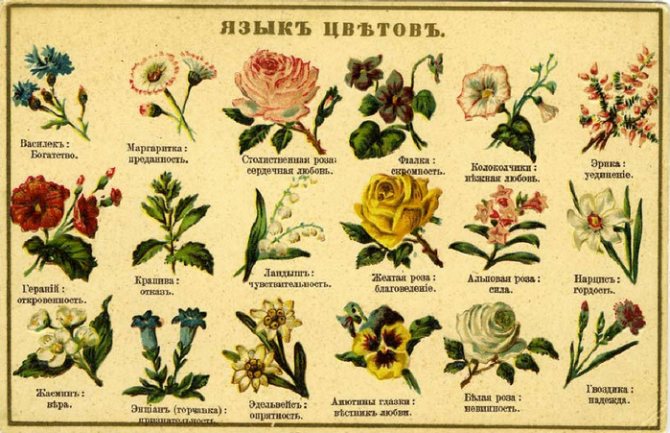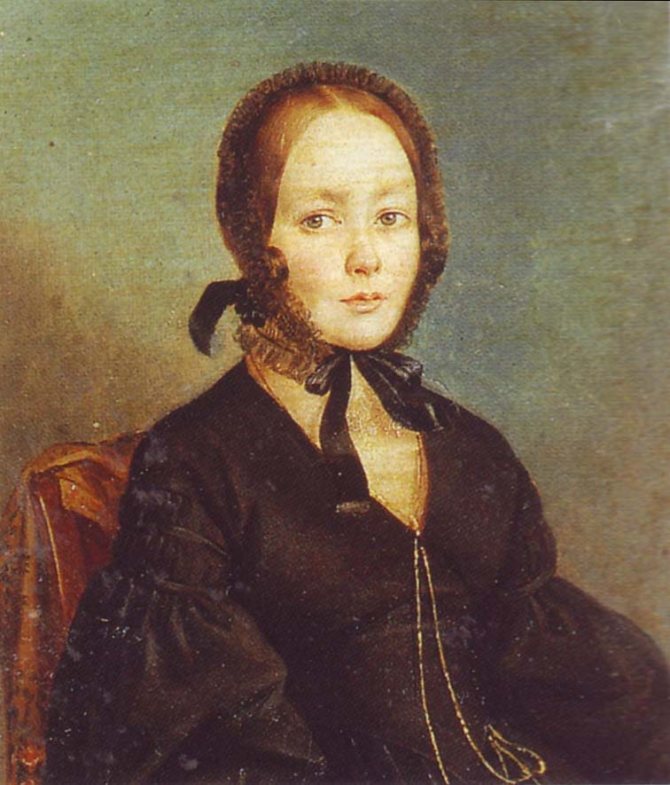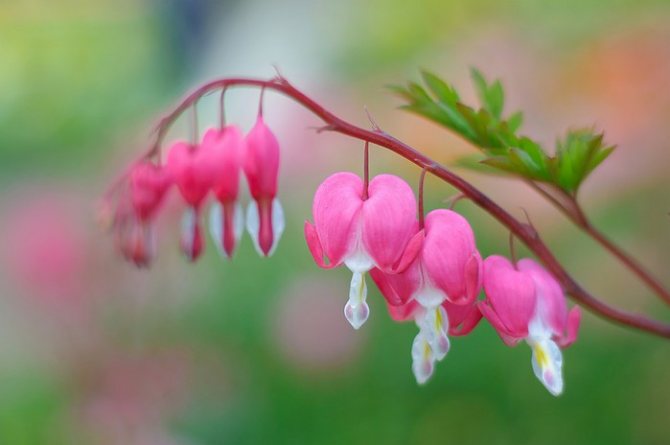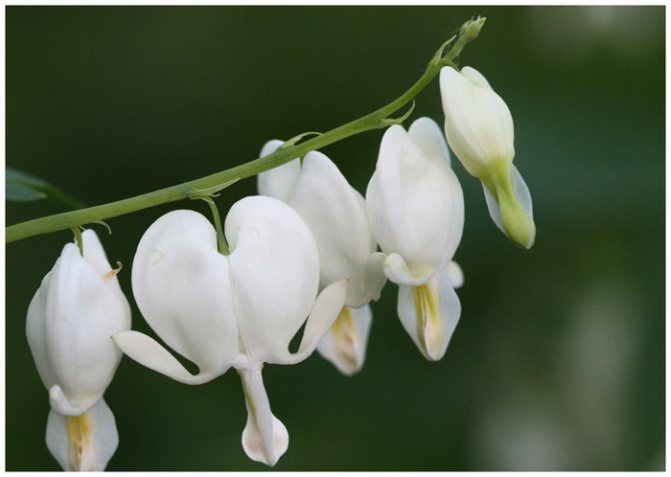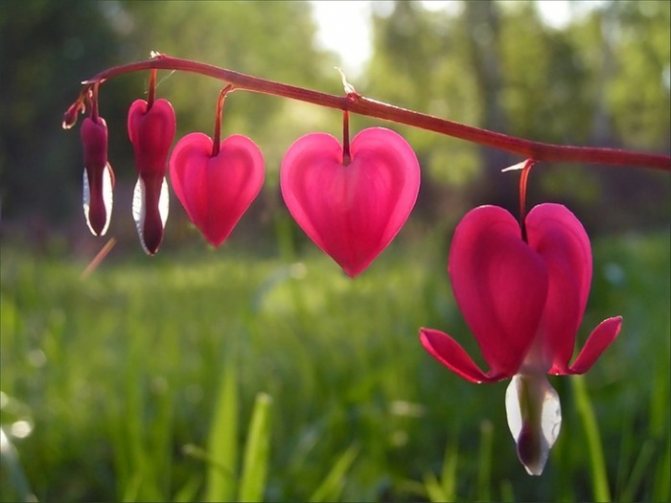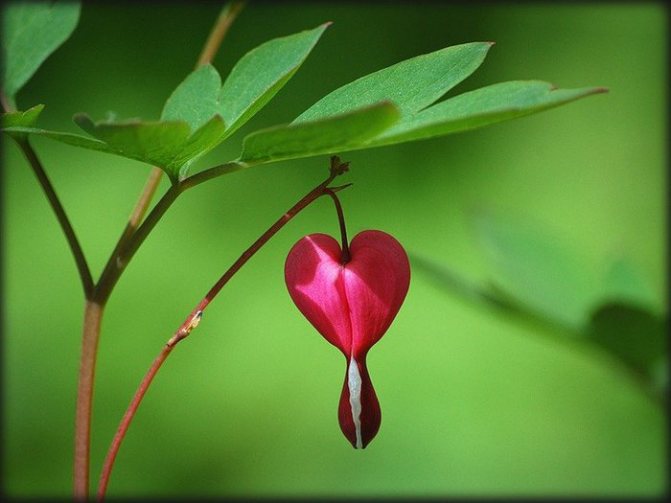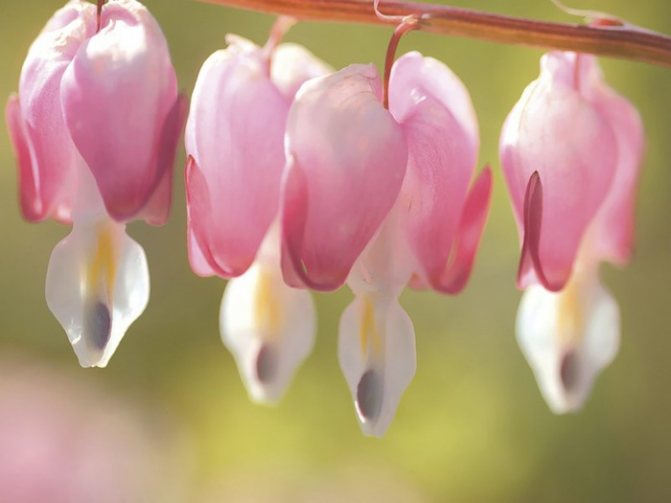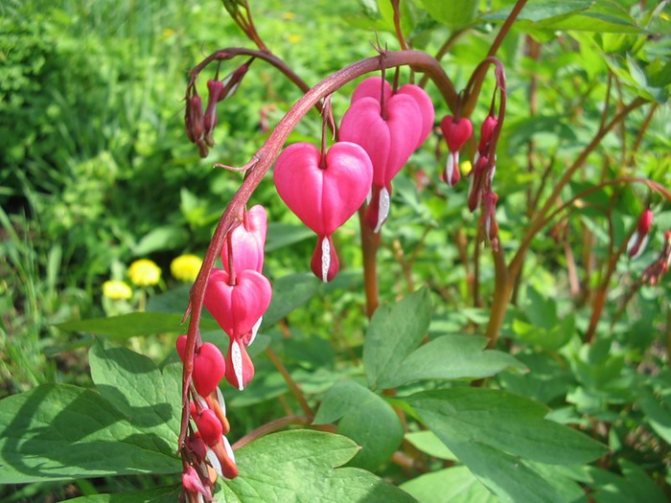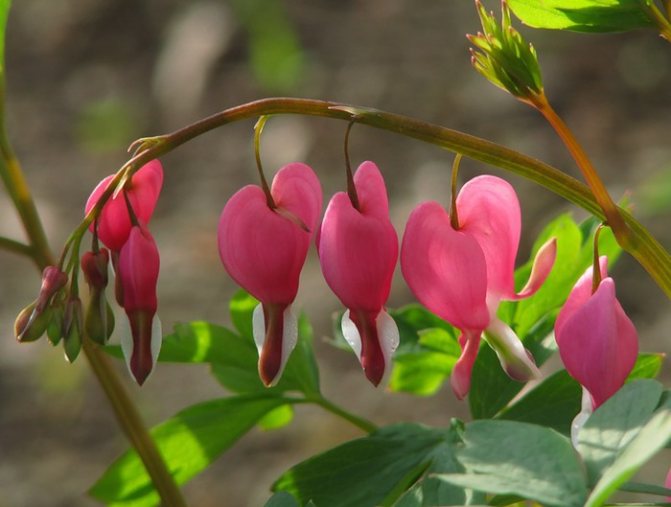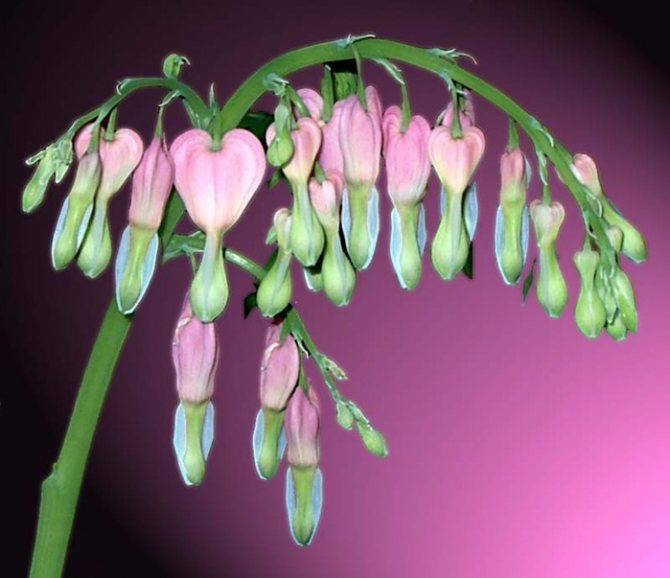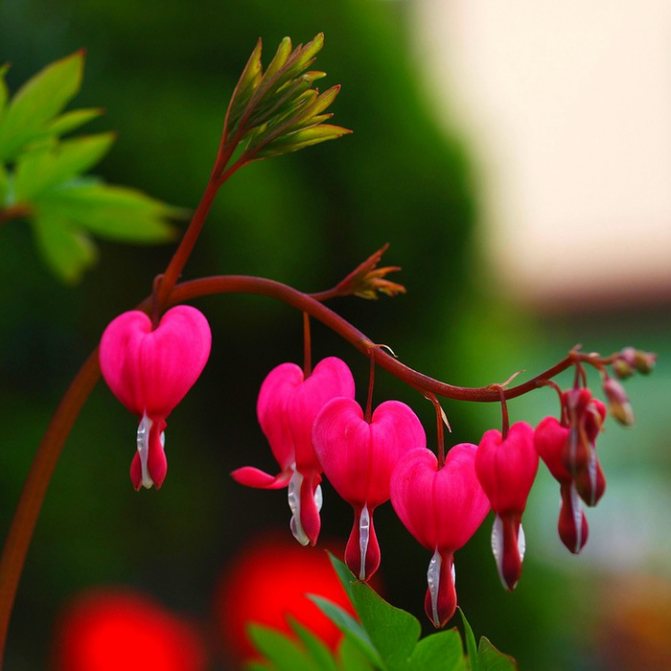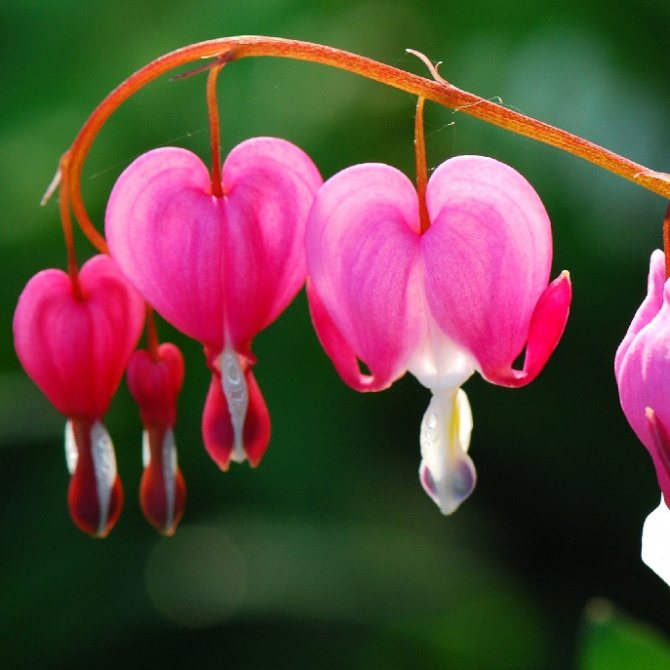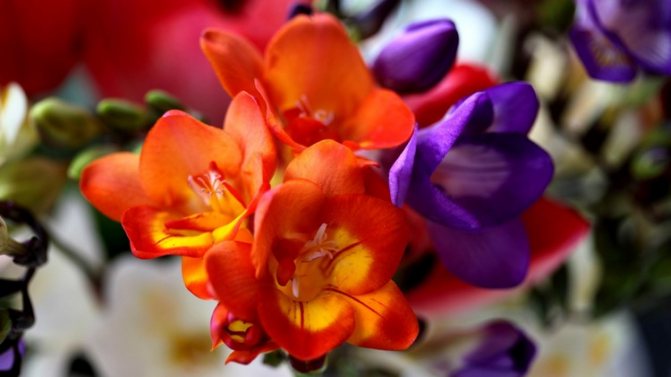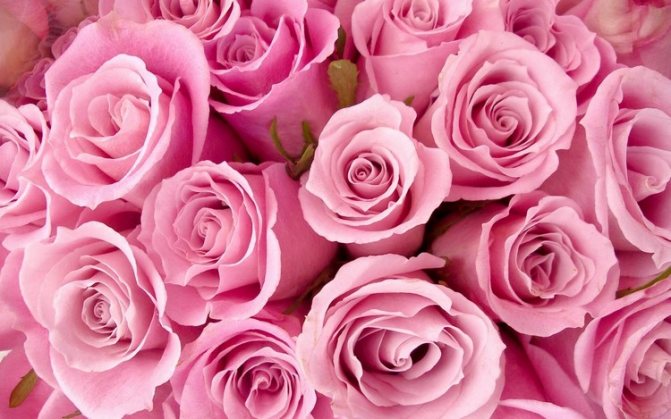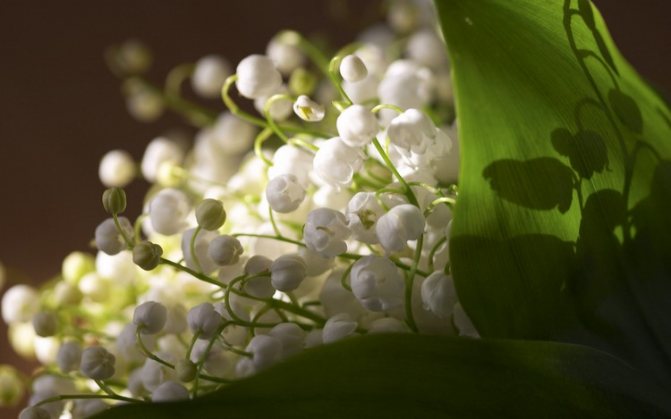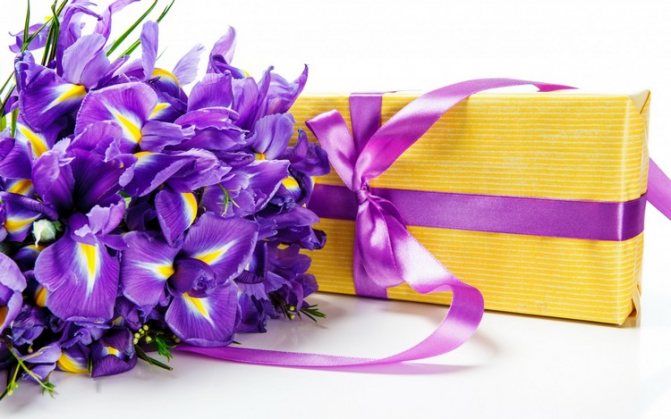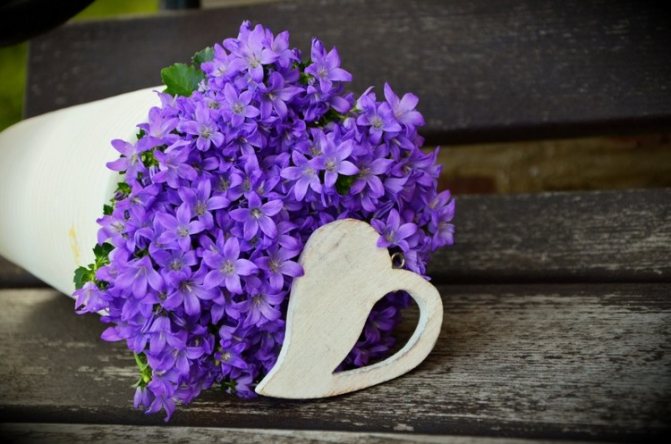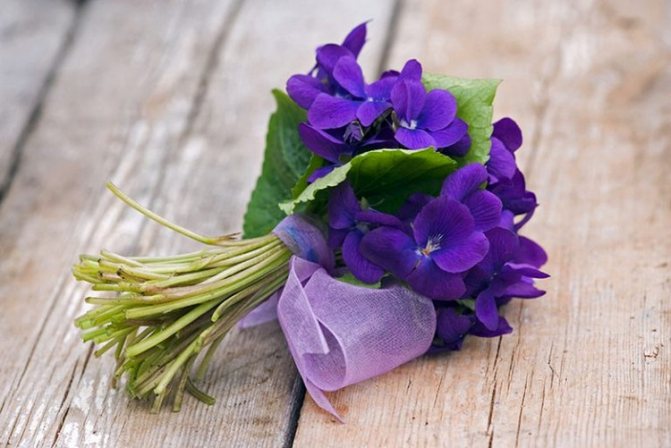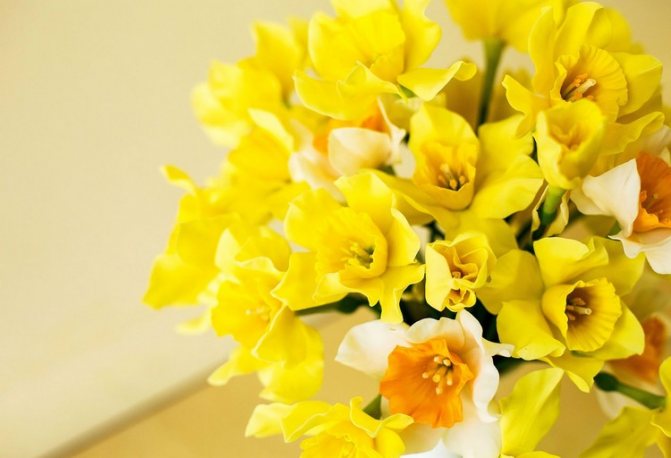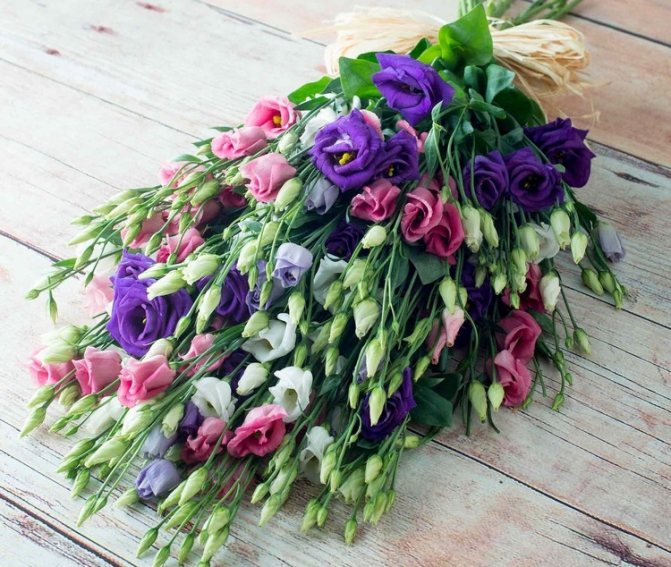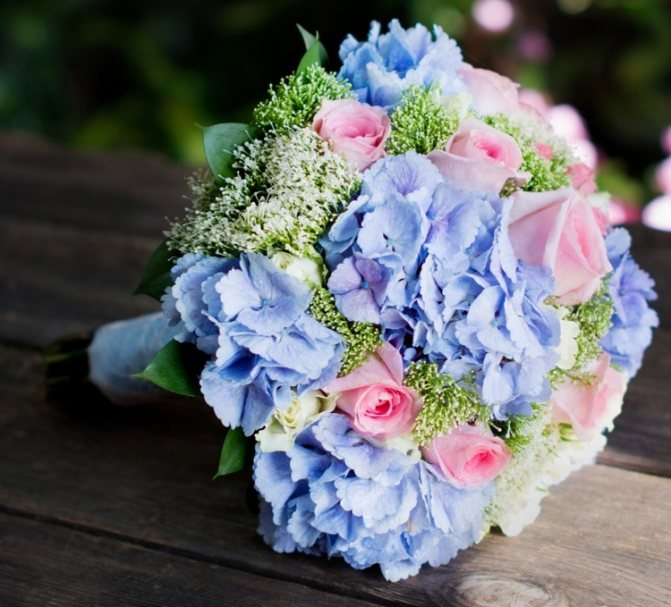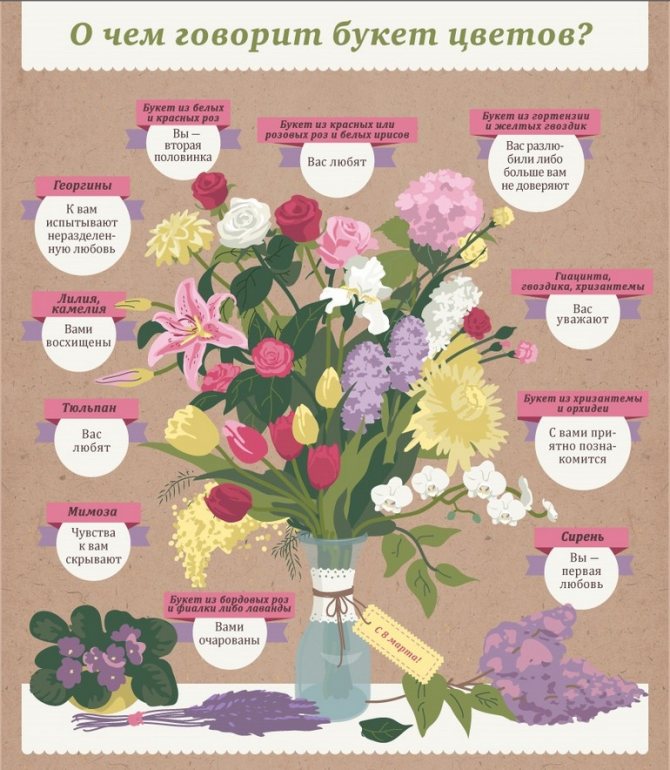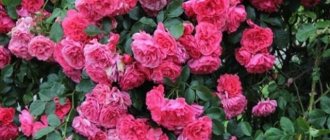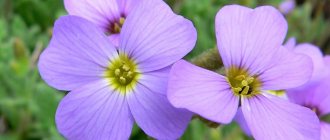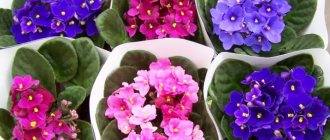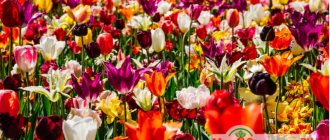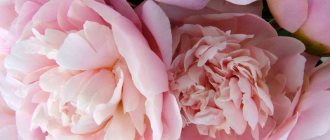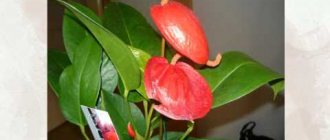The language of flowers has become popular again in our time, however, of course, it does not find such widespread use as in past times, when young people were completely fond of it. Everyone knew how to compose and decipher the message carried by this or that bouquet of flowers. How convenient it would be if such a language was used now - after all, it is not difficult to master it, it is universal and would be understandable to everyone, even if the donor and the addressee speak different languages.
Where did the language of flowers come from? It originated in the East and was widely used both when offering bouquets and in lyric works. The language of flowers came to Europe in the 18th century and became very widespread in secular society - it was used at balls, in games and in letters.
The flower language, like any other, has changed over time and adapted to the conditions in which it was used - after all, each locality has its own favorite flowers. Sometimes the symbolism of the flower changed, did not coincide with its original oriental interpretation. For example, phlox had two interpretations - it could mean humility and consent, but at the same time it was a symbol of fiery passion.
In Russia, the popularization of the language of flowers is associated with the name of the poet and translator Dmitry Petrovich Oznobishin, who published the Persian book “Selam, or the Language of Flowers” translated by him into Russian. In this book, more than 400 plants were described, each of which corresponded to a certain word or phrase. The book was quite popular, of course, primarily among young people.
Peony: "I will give you the whole world!"
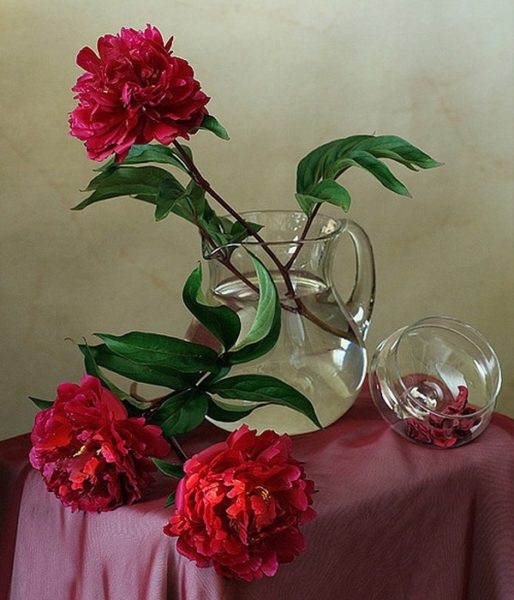
Peony is a sign of the promise of a happy marriage and a cloudless life, at the same time, bashfulness.
Color
Primary colors expressing feelings, attitudes and ideas
- red is the color of life and love (hence a rose is a symbol of love, a carnation is a passion), and also as the color of blood, a symbol of anger and revenge (the color of war and revolution);
- white - a symbol of purity and innocence (lily);
- black - a symbol of sadness, mourning;
- yellow - a symbol of disgust, hatred; except for golden - a symbol of the sun and joy;
- green is a symbol of hope;
- blue is the color of the gods;
- blue - a symbol of fidelity (forget-me-nots, violets);
- purple is a symbol of greatness.
Married life and peonies
Fresh flowers in a vase that are in the bedroom, or just photos of peonies in Feng Shui are considered a real magnet, attracting a new wave of passion and romantic feelings into relationships. When such a talisman is in an intimate room, the spouses begin to treat each other with reverence. This action of a peony is its undoubted plus. Note that this talisman gives some couples emancipation, frees them from excessive shyness and complexes.
Feng Shui counts the peony as one of those things whose capabilities cannot be predicted in any way. Experts advise not to lose sight of the negative side of the action of such a talisman, which is that a peony can stir up a new galaxy of romantic emotions. Peony can push one of the spouses to a banal betrayal. To prevent this from happening, a picture of these flowers (or another similar Feng Shui talisman) should be hung in the bedroom for a short time. In order to refresh the relationship, you do not need to hang an image for a month or two; a few days of this attribute staying in the room will be enough.
Peonies for career and business
Since ancient times, it is believed that the peony is a "royal" flower, a flower of emperors and power. He is not only a symbol of aristocracy, exclusivity and courage, but also personifies the upward movement in the field of achievements.
If you are planning to make a breakthrough in the field of business or move up the career ladder, then the peony will be appropriate. A bouquet of such flowers should be placed in the living room or in the office, thanks to which you will receive a charge of good luck and positive energy. If you don't want live plants, you can hang a picture. In winter, to maintain the energy of success, you can decorate your apartment by hanging a painting in soft colors on the north wall.
It is believed that peonies can cause warm feelings, extraordinary love, mutual passion, and also contribute to the construction of new, exciting relationships.
Peonies in landscape design Planting and caring for a tree peony
- Similar posts
- Varieties of hydrangea paniculata for the Moscow region with a photo and description
- Clematis - how to choose and grow the best species
- Marigolds rejected Tagetes patula
«Previous post
Rainbow psychology
All of us in childhood rejoiced at the appearance of a rainbow in the sky after the last rain. Everyone tried to memorize the number and sequence of the colors of the rainbow. Who among us does not remember such funny phrases as:
- TO
every
ABOUT
hotnik
F
wants
Z
nat,
D
de
FROM
walking
F
adhan. - TO
ak
ABOUT
twice
F
ac-
Z
stinker
D
olova
FROM
broke
F
onar. - And other options.
Where the first letters of the words mean the corresponding color name:
- TO
each is red; - ABOUT
hotnik - orange; - F
wants - yellow; - Z
nat - green; - D
de - blue; - FROM
walking - blue; - F
azan - purple.


But we did not even think at that time that each color affects us, our character and our life to one degree or another. And, now, having already become adults, we can trace the psychological connection of a certain color, preferred by us, with this or that trait of our character.
What do peonies mean in Feng Shui
According to ancient Chinese teachings, the flower personifies masculine yang
... Live or painted peonies attract positive energy and have a beneficial effect on the room. If they are placed in the work sector, a person will begin to move up the career and social ladder. If you put a bouquet of peonies in the living room, an unmarried girl will quickly meet a soul mate. It attracts love and passion. But in the bedroom, peonies must be handled with care. They increase sexual energy. This will help to diversify the life of the spouses, but it can push one of them to cheating if his libido does not find a way out in the family.
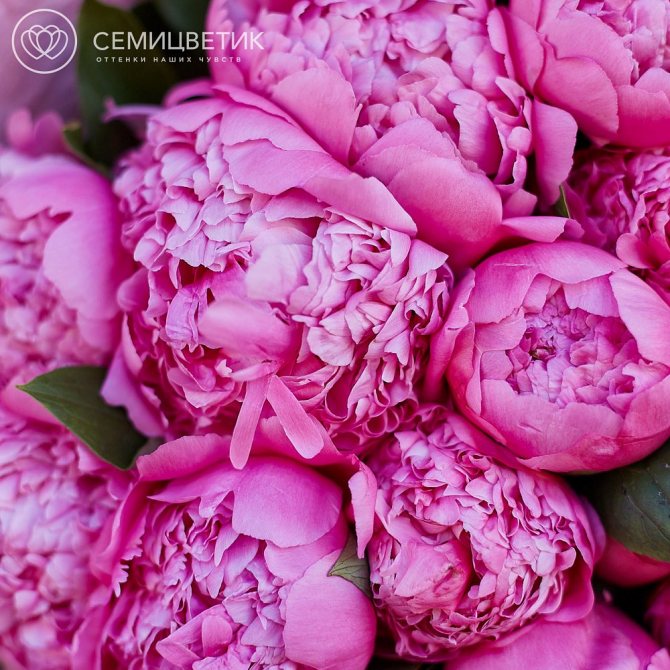

Red in psychology
Since ancient times, people have shown a special interest in the color red. In many languages, the same word means red and in general everything is beautiful, beautiful. Among the Polynesians, the word "red" is synonymous with the word "beloved." In China, a sincere, frank person is said to have a “red heart,” while the heart of a bad, insidious person is black.
Red - exciting, hot, energizing, association with danger and aggression. Red is easy to draw attention to any advertisement. Pulse and blood pressure can increase if you look at red for a long time. Red tires quickly.
The meaning of red in psychology
People who prefer red love to be leaders. Almost all their feelings are at their maximum. They are persistent, do not like to postpone the case. It often happens that those who prefer red are demonstrative and selfish, intolerant, stubborn and cruel. The woman in red tends to flirt with guys more often than not.
Red also denotes power, greatness. In Byzantium, only the empress had the right to wear red boots. The emperor signed in purple ink, sat on a purple throne.For many peoples, red symbolizes the south, flame and heat.
Aggressive colors are red, red-orange.
Purple
Figuring out what color of flowers means, you cannot get around and the last shade of the rainbow. Purple flowers are usually given to someone who is successful. This is the color of the winner who was able to achieve the set goal. And since purple subconsciously adjusts to success, parents of graduates can use it. For example, to give your daughter a bouquet of irises before the exam, as if telling her that they believe in her, they know that she will cope.
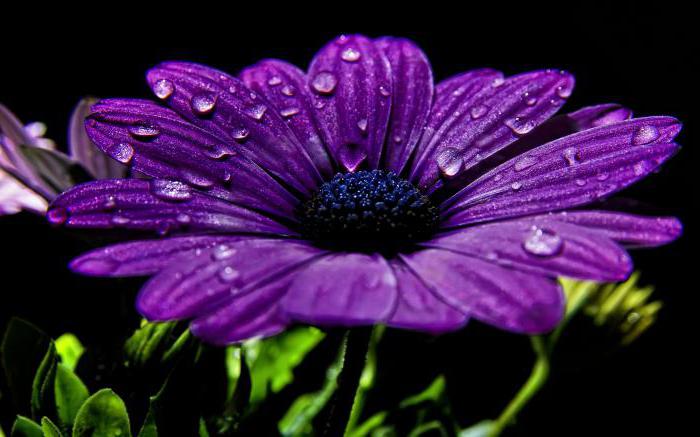

Also purple is the color of gratitude. Such flowers can be presented to a teacher, grandmother or mother. You kind of say to adult ladies: "Thank you for what you did." It will be nice for an older sister to receive such a bouquet. After all, she helped her brothers and sisters all her life, taught and mentored them, and therefore deserves a pleasant gift.
Pink color in psychology
Pink is a soft color that dulls the emotions of anger and aggression. In places where children with antisocial behavior are corrected, pink walls or furniture are often used. If after a hard day you come home angry and aggressive, look at something pink and your aggression disappears.
Pink can mean goodness, passion, romance, love. Those who prefer pink want to live life to the fullest, want new experiences, are hardworking and do not like to relax. But sometimes people who prefer pink can be frivolous, childish, loving to show off in front of everyone.
The value of pink in psychology
Pink is the color of life, of all living things. He talks about the need to love and be kinder. Those who like him can get excited about the smallest thing. For people who are overly pragmatic, this color causes irritation.
What is more romantic - a rose or a peony?


Shot from the series "The Mentalist"
In the distant and terrible times, when people did not have not only the Internet, but also emoticons to express their emotions, the meaning of flowers in a bouquet was sometimes even more important than the very fact of such a presentation.
Now everything has become much easier, and not every girl will look for a secret subtext in the flower you donated. Although it may well do it.
The meaning of flowers in a bouquet is like a foreign language, which is not difficult and not long to learn, and can be used in different ways. See for yourself - it's worth spending a couple of minutes!
Orange in psychology
If you're in a bad mood, look for something orange. Orange will certainly cheer you up, especially if it's winter outside.
In winter, everyone rejoices in orange even more than in summer, due to the lack of sun. It's hard to imagine effective advertising without orange.
The meaning of orange in psychology
People who prefer orange are creative people. They are strong, freedom-loving, forgiving everyone. They have inexhaustible energy that must be spilled out, for example, by creating another masterpiece. Orange lovers can have a high opinion of themselves.
Orange is a favorite color for intuitive people and passionate dreamers. In heraldry, this color also means hypocrisy and pretense.
Shades
White
Color brings lightness, perfection, purity and harmony. White flowers can be added to a bouquet whenever you want to leave a positive impression. Such a shade is able to open the door to new opportunities for a person.
On the other hand, a completely white bouquet, without bright additions, can be a symbol of sadness, driving you into a state of melancholy.
Yellow
The synonyms for yellow are optimism, youth, reliability and originality. The color of the sun and good mood.
However, according to other interpretations, yellow is betrayal, stinginess and lies.In some cultures, especially Western ones, yellow flowers are a sign of separation and parting. Therefore, it is not customary for us to present bouquets made up of only yellow flowers for a holiday. Such compositions are more often brought to funerals.
But in China, on the contrary, a pure yellow bouquet is considered the most optimistic.
Shades of orange
The juicy orange color is always eye-catching. Orange will give energy, uniqueness and extravagance. It symbolizes strength and power: flowers of this shade are often given as a sign of respect. Orange flowers in a bouquet always mean joy, good mood and enthusiasm.
Bright red, burgundy
A shade of passion that attracts to itself, but at the same time evokes a sense of anxiety. Contradictory color: love and intimacy oppose war and blood.
Red leaves no one indifferent. These flowers are worth giving if you want to say something important. The more serious the degree of your intentions, the richer the color of the bouquet can be. But just like that, on duty, for example, on March 8, it is better not to present a pure red bouquet.
Light pink
The color gives sweetness, femininity, charm and sensuality. Its meaning is youth and purity. These shades represent sympathy and admiration. Indicate a willingness to look after and take care of. Pink is the embodiment of politeness, elegance and courtesy. It is good to give a pure pink bouquet to young girls, but not to adult ladies.
Purple, lilac
The meaning of this color is often mystical. It is distinguished by mystery and unusualness. It evokes nostalgia, awakens fantasy. Responsible for high ambitions.
Such flowers are given when they want to emphasize friendly and trusting relationships. Sometimes it is a symbol of affection.
Choose this color when you want to say, "I appreciate your sophistication." Compositions made only of lilac-violet flowers are good to present to elegant adult ladies related to art.
Blue paints
This color means peace, sympathy, trust and serenity. From negative values it is possible about and "detachment". If you give blue flowers, it will speak of loyalty, devotion, noble feelings. The lighter the shades are, the less "coldness" and more serenity there will be.
Yellow in psychology
Yellow is the color of gold, which since ancient times has been perceived as a frozen sunny color. It is the color of autumn, the color of ripe ears and withering leaves, but also the color of disease, death, the other world.
For many peoples, women preferred yellow clothing. Often, yellow served as a distinctive feature of noble people and the upper classes. For example, Mongolian lamas wear yellow clothes with a red sash.
On the other hand, among some peoples of Asia, yellow is the color of mourning, sorrow, sorrow. In Europe, a yellow or yellow-black flag stood for quarantine, and a yellow cross for plague. Among the Slavic peoples, yellow is considered the color of jealousy, betrayal, and in Tibet, jealousy is literally called "yellow eye". Let us also recall the "yellow press" and the "yellow house"
The meaning of yellow in psychology
Yellow stimulates the brain and nervous system. Yellow is joy, warmth and faith in the best. The combination of black letters on a yellow background is the most advantageous for the most effective advertising, as it contributes to better memorization of the text. But do not overdo it with yellow, as it can overexcite the brain and anxiety can arise.
People who love yellow want to reveal themselves, to achieve the goal they have set for themselves. They are self-confident, joyful and cheerful. These people often have a high level of creativity. Yellow helps them in difficult times, concentrates their attention. Sometimes they like to gossip, or just chat, and are often scattered and critical of themselves and others, but their self-esteem is not at all low, but vice versa.
What flowers are customary to give in a bouquet
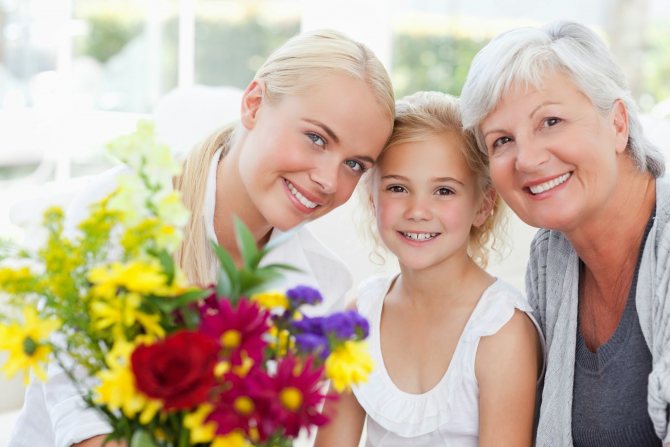

Collecting a bouquet of flowers for special moments in life, they pay attention to who the gift is for. A bouquet of flowers can be given to friends, loved ones, parents. Let's see what flowers you can give to whom:
- For girls - lily of the valley, lavender, orchid, forget-me-not, rose, lilac.
- Spouse - hyacinth, poppy, red rose, sakura and apple tree twigs.
- To a friend or sister: chrysanthemum, chamomile, rose.
- For mothers: carnations, lilies, lotus, yellow roses, orchids, chrysanthemums.
- For grandmothers: sakura twigs, magnolia, roses, tulips, violet.
The number of flowers in a bouquet is also important. One flower shows attention, three - respect, five - love, seven - passion, nine - admiration. In our country, it is customary to give an odd number of flowers, but in the world they give an even number. So 8 and 10 flowers in a bouquet are popular in Europe, such a gift means gratitude. According to floral etiquette, flowers are given not only to women, but also to men. What flowers are given to men can be seen in a small video:
Green in psychology
Green is a natural, calming and relaxing color. Green has healing properties, normalizes high blood pressure. People who choose green choose their path in life clearly and rationally.
Any task in life is taken with the utmost seriousness. They love to help others. Their inner world is rich, but they are in no hurry to open it, even though they themselves are not secretive.
The meaning of green in psychology
Green is the color of grass and leaves. For many peoples, it symbolizes youth, hope, fun, although sometimes - and immaturity, lack of perfection. Green is extremely material and has a calming effect, but it can also produce a depressing impression (it is no coincidence that melancholy is called "green", and the person himself "turns green" with anger).
The people of Iran associate green color both with rapid growth and freshness, as well as with misfortune, sadness, grief, therefore, they say about the unfortunate person "green foot", and about the cemetery - "green house". In medieval Europe, jesters wore green and yellow clothes, and bankrupts in Germany were required to wear green hats.
Our summer is winter, only painted green. Heinrich Heine
Login to the site
Young Frenchwoman Jeannette went to the forest to pick berries and got lost. Where she does not go, there is no path. Wherever he looks, the forest stands like a wall. The girl got scared and began to call for help. For a long time Jeanette wandered and called, but only an echo answered her, and the treetops sympathized with grief with deep sighs. She was exhausted at the end of Jeannette, sank down on a fallen tree and dozed off. She doesn't know how much she slept, but she woke up because someone licked her on the cheek. The girl shuddered, opened her eyes and saw a hunting dog, and nearby - a young rider. - Get in the saddle! - invited the young man. - And do not hesitate, otherwise we will not get out of the thickets before dawn. How long or short the horse drove them, Jeannette did not remember, she only remembered how tightly the young man held her in warm embraces ... And when they were near the outskirts, the young man took the girl off the saddle and kissed her warmly goodbye. Jeannete remembered her first kiss, and she had a desire to see the young man again, but he did not appear. He did not appear either on the third or fourth day. On the fifth, a rich cavalcade rode through the village, a horseman familiar to Jeannette flaunted in front of him, and next to him was a happy blonde girl ... Jeannette swayed, blood hit her face, and her heart suddenly sprouted in a crimson flower.
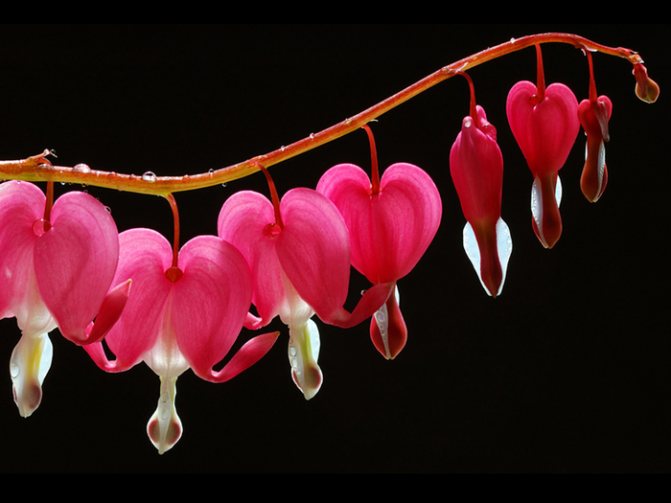

The hot summer is ripe: a fruitful time, And Jeanette went to the forest for berries in the morning. Step by step, unnoticed, she wandered off the path into the thicket, Lost, she was frightened and she began to cry.
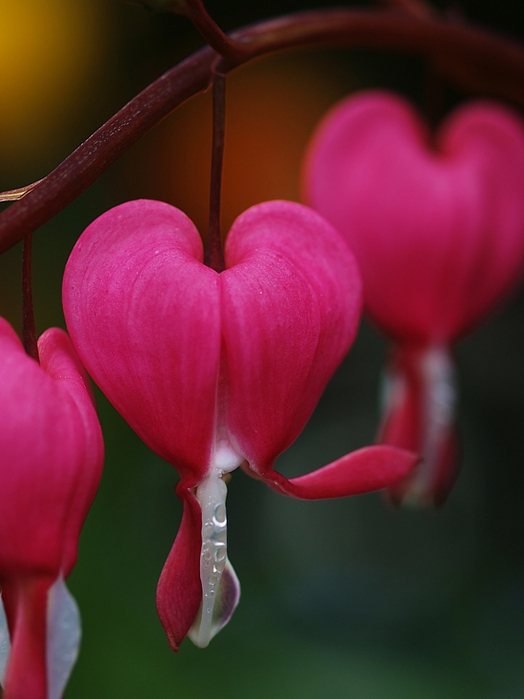

A raven croaks on a branch, a thicket of thick walls, the forest to the left, the forest to the right, and Janet is all alone.She shook with fear: “Help, somebody! Kind people! For help! Show the way to home! "
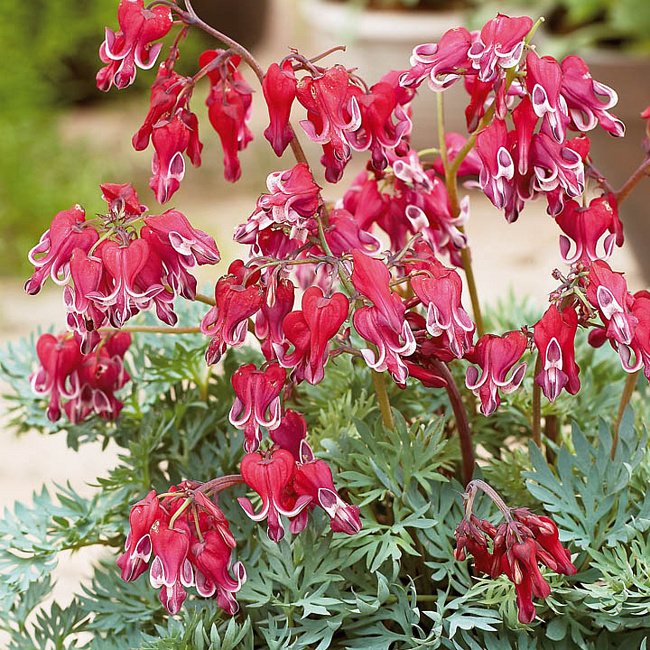

Only an echo is heard, the leaves rustle quietly, The sigh of the trees, the crackling of a magpie, and an alarm like an alarm. Jeanette was exhausted, a tear runs down her cheek, Sank down on a snag, fell into the abyss of sleep.
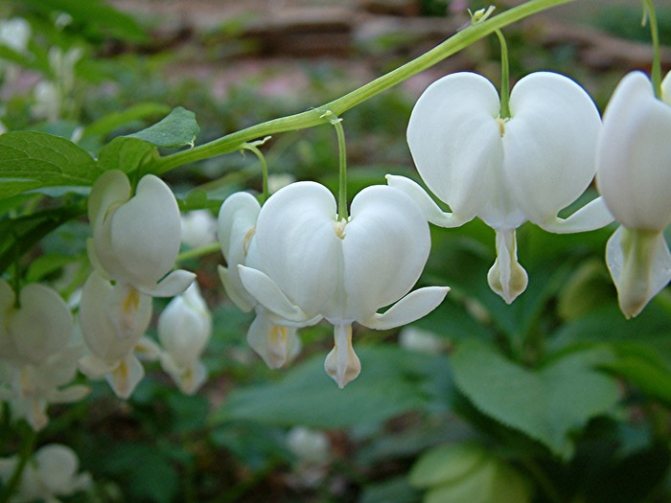

How much she slept is not known, but she woke up because the Hunting Dog touched her cheek with his tongue. Not far off, a gallant rider on a hot steed, Bent over, lifted the maiden and hugged her to him.
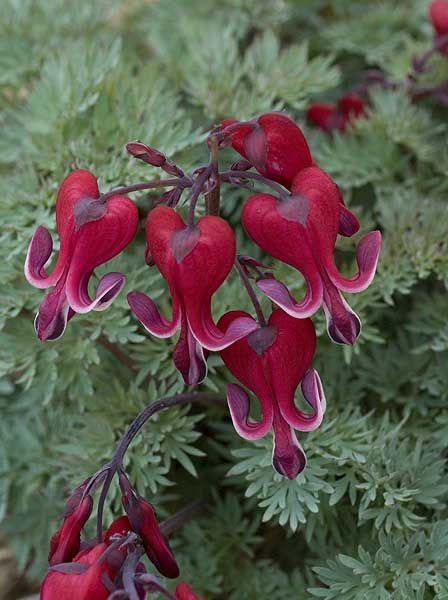

He embraced Janet with his arms, she blushed, From the embrace of hot, tender both bodies, like a string. I don’t know how much they drove, finally, and my father’s house, Kisses of hot lips ... The rider disappeared behind the hill!
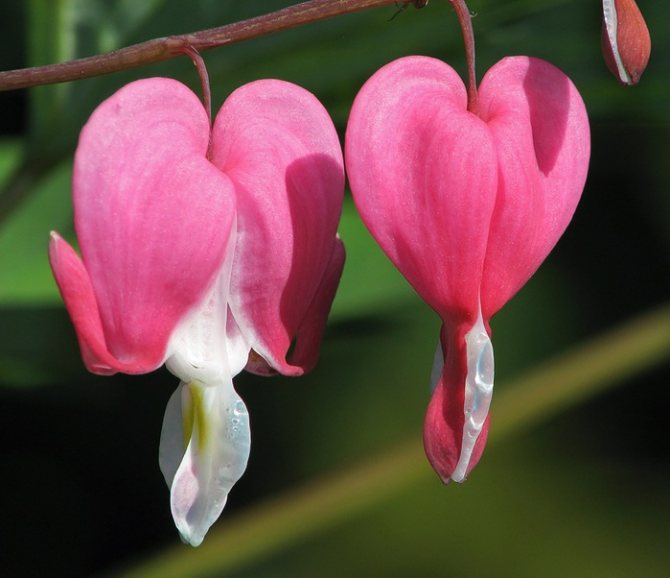

Bewitched by love, Janet is waiting for him back, A day passed, then a week, looked through all eyes. But one day the cavalcade, the same rider at the head, Galloped early in the morning, but the other one with him in the saddle.
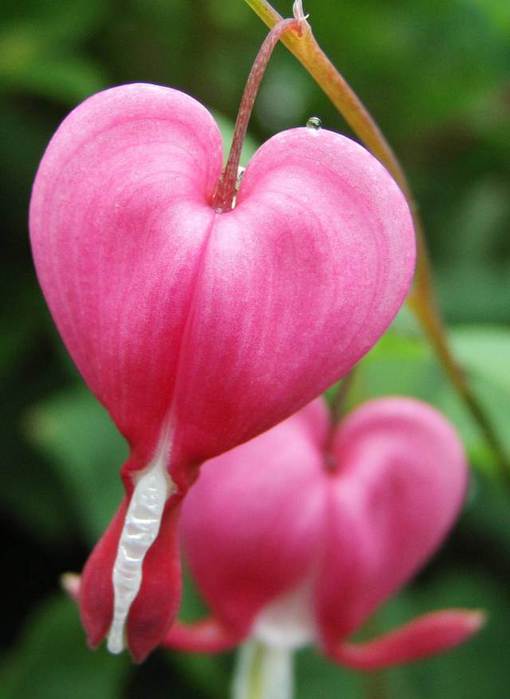

Jeanette suddenly swayed, blood hit her face, Heart broke in two, it sprouted into a flower. The dark red Dicenter-heart of young Janet, That unrequited love, on the ground a bloody trail.


Katya Andrienko
Blue in psychology
For many peoples, blue symbolizes heaven and eternity. It can also symbolize kindness, loyalty, constancy, disposition, and in heraldry it denotes chastity, honesty, glory and fidelity. "Blue blood" speaks of a noble lineage; the British call the true Protestant "blue."
In addition, blue is close to black and receives symbolic meanings similar to it. It was considered mourning in Ancient Egypt and among some peoples of South Africa. The French call horror “blue fear” (remember the tale of the “blue beard.” Among the Slavic peoples, blue served as the color of sorrow, grief, and was associated with the demonic world. Ancient legends describe black and blue demons.
Blue
You have already begun to understand a little what color of flowers means what. Now let's talk about blue colors. It would be appropriate to give such a bouquet to an adult. Blue symbolizes stability and consistency. Since ancient times, he represents nobility. Therefore, a composition of blue flowers can be presented to a professor, academician or scientist.
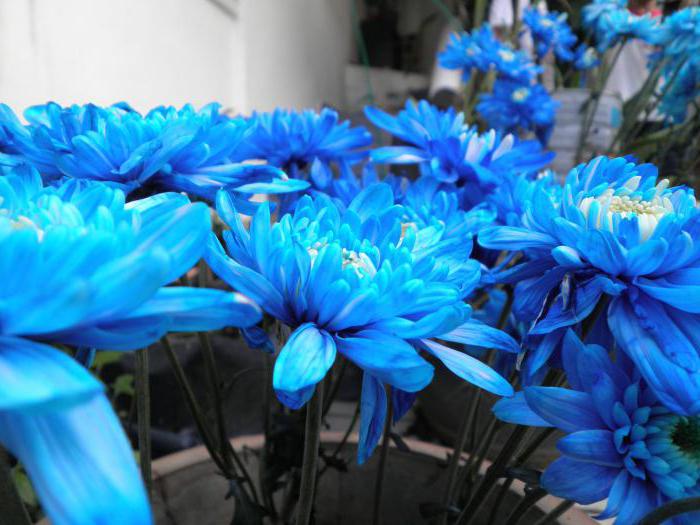

If the husband gives such a bouquet to his wife, then he wants to tell her about the fidelity and stability of his feelings.
Blue flowers look very unusual. Therefore, they are often presented to creative people, for example, artists, sculptors, musicians.
Blue in psychology
If you want to instill confidence in someone, wear blue clothes. Blue will not only inspire confidence, but also respect for your person, and will also emphasize your high social status, and show others that you are inclined towards stability.
Water and ice blue soothes and cools. The heart rate becomes lower. If you want to motivate employees to work efficiently, paint your office walls blue. This will help not only to work productively for office staff, but also to train weightlifters more efficiently. It is proven that in rooms with blue walls, the performance of athletes is increased.
History of origin
The history of the red gerbera began three hundred years ago... In the first half of the 18th century, Dutch travelers discovered bright, unusual flowers in southern Africa.
A little later, the botanist Jan Gronovius described an unknown flower and began to study it in earnest. Since he did not yet have a name, the scientist gave him the name of his friend, the doctor Traugott Gerber.
The flowers found were of a wide variety of colors and shades, including red (you can find out what types of gerberas are known today here).
Purple in psychology
Purple is a dangerous color. It puts pressure on the psyche, causes apathy. At the same time, purple increases low self-esteem
People who love purple are unusual - not like everyone else. It is difficult for them to realize themselves in life, they are usually very self-critical, they always control themselves very rationally.
The meaning of purple in psychology
Purple also symbolizes the inherent infantilism and suggestibility of a person, the need for support, support. In this sense, the choice or denial of the purple color acts as a kind of indicator of mental and sexual maturity.
Features of composing compositions
When decorating a floral ensemble, the florist will ask you who you are going to give the bouquet to and for what reason. Of course, it is important to take into account the preferences of a person close to you, but in case of difficulty, you should always consult a specialist. He will take into account the age of the recipient, and his taste, and the importance of the event.
- For young girls. It is customary for young ladies to give small rounded compositions. Of the "solid" flowers, lilies and orchids fit perfectly into such bouquets. If you want to gift roses, prefer light shades. It is appropriate to give a bouquet of peonies to a young wife or future bride.
- For older women. In this case, it is worth taking a closer look at massive compositions, which will include dark roses or large chrysanthemums. The shape of the bouquet does not play a special role here. The main thing is that the flowers are bright, and the bouquets do not look cheap.
- For men . If you are going for a gift to a representative of the strong half of humanity, choose discreetly elegant bouquets. Flowers in this case must be selected very carefully. Better to give preference to irises, gladioli, carnations or gerberas.
Lilac color in psychology
What does lilac mean in human psychology?
Lilac color is one of the shades of purple, as well as a mixture of blue and red (a mixture of feminine and masculine principles), means a bright future. Blue in this shade gives a certain chill, which also gives the meaning of nostalgia, and red - creativity.
Therefore, if we speak succinctly about the lilac color, then this is a clear future, nostalgia and creativity. A similar description is often found in adolescents who are full of strength, but at times they have depression, and they also have everything ahead.
The meaning of the lilac color in psychology
Also, as shown by the results of various studies, lilac color raises a person's self-esteem well. Therefore, people with an underestimated indicator are advised to wear lilac tones or jewelry.
Lilac color in human psychology is vanity, immaturity. Often this color is chosen during adolescence.
Lilac color in the psychology of women
If the lilac color is liked by the female sex, this means that she has a creative inclination or the ability to fantasize and imagine well. It is also generally accepted that such girls like to cheat themselves, while experiencing severe stress and depression. On the other hand, such representatives of the fair sex are cautious, have a desire for harmony and aesthetics.
Usually a love of color leads to a matching wardrobe color. But it is worth remembering that everything is fine in moderation, you should not overdo it, since an overabundance of this shade can cause disgust from the people around you.
What does the color of peonies mean
Ball-shaped inflorescences do not have a very large color palette. Let's take a look at the meaning of the most popular shades:
- White and light pink
peony inflorescences symbolize shyness and some bashfulness, so it is appropriate to give them to girls, girls and brides.
- Pink peony bouquet
- the most romantic surprise. He is a symbol of love, care and tenderness.
- Saturated red shades
are considered noble and personify respect, power, wealth and well-being. They can be donated to a teacher, university lecturer or dean of the faculty, mother or grandmother. In any case, with such a gift you will emphasize the status of the recipient, wish him prosperity, professional and personal success.
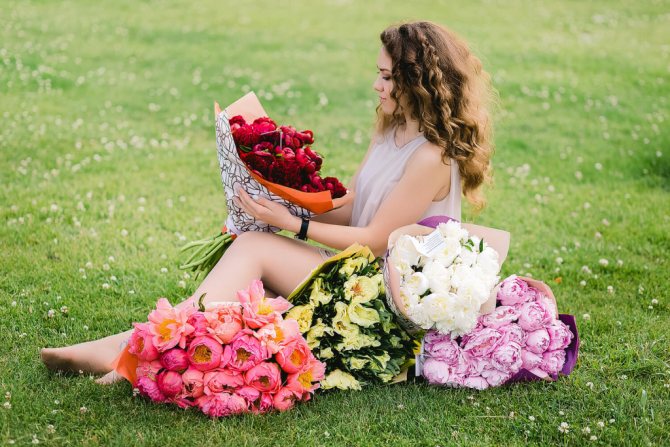

Black color in psychology
Black color in psychology, as a rule, symbolizes misfortune, grief, mourning, death.So, in ancient Mexico, during the ritual sacrifice of a person, the face and hands of the priests were painted black. Black eyes are still considered dangerous, envious. Sinister characters are always dressed in black, the appearance of which portends death.
Black is authoritarian.
If we see a man or a woman in black, or a black car, then subconsciously they become more significant for us. This is probably why the limousines of rich and wealthy gentlemen who want to seem authoritarian are black, like their clothes. Black color means not only authority and weight, but also aggressiveness. There is such an interesting fact: football referees often punish the team that has the black uniform with free kicks, as well as yellow and red cards.
People who prefer black are mysteries. They want to unconsciously attract the attention of others, since black is curious, because it hides something interesting and scary behind it. If you wear only black, then this may indicate that you are missing something significant in life. Thus, you protect yourself from unpleasant reality, you try to hide. Better to get out of this state. But this should be done slowly, gradually changing the attributes of black clothes to other bright colors.
The meaning of black in psychology
It is believed that there is a connection between black color and sex appeal. In some African tribes, women with very black skin are highly regarded as lovers, but not as wives. Passion for love is shrouded in darkness and mystery; therefore, black can symbolize something intimate and passionately desired. Among the Arabs, the expression "blackness of eyes" means beloved, "blackness of heart" - love.
Thus, black can also have a favorable meaning. It is perceived as such, for example, in the arid regions of Africa, where there is little water and black clouds promise fertility and abundance. Black bulls, goats or birds are sacrificed to the guardian spirits who send rain, and the priests also dress in black.
Gray in psychology
Gray in psychology is a neutral color. Rarely will you meet someone who would love gray, and just as rarely will you meet someone who cannot stand gray. Gray does not distract from the important matter, which is why business people prefer it. At the same time, gray is quite friendly and reliable.
The meaning of gray in psychology
Usually, those who prefer gray put reason first, not emotion. Gray clothing gives strength to insecure individuals.
What does a peony tattoo mean
Tattoo artists believe that the meaning of a tattoo is not associated with the historical understanding of the image, but with the nature of its bearer and the meaning that a person puts into it. Usually, for girls
drawing peonies means
beauty and sex drive
... But do not forget that this plant is a carrier of male energy. His image as a tattoo
gives a man strength, stamina and belligerence
.
Many people get a peony tattoo as a symbol of a talisman. Such a talisman saves from ailments, evil and negative energy.
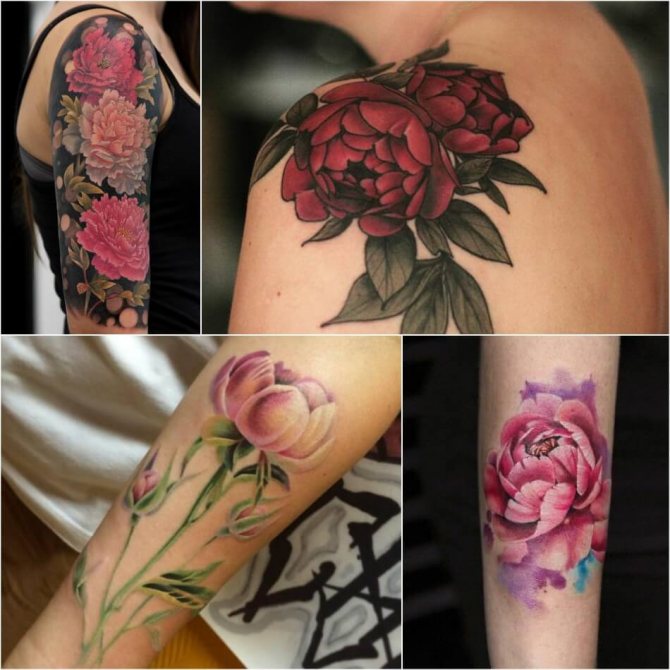

We did a quick overview that means peony
in different cultures and countries, and also learned how to interpret his image on the body. The main thing to remember is that the peony is a truly majestic and beautiful flower. If you present him as a gift or give some thing with his image, the present automatically becomes royal.
White color in psychology
White color in psychology symbolizes purity, spotlessness, innocence, loyalty, virtue, joy. It is associated with daylight, as well as with the generating force that is embodied in milk and eggs. Whiteness is associated with the idea of the obvious, generally accepted, legitimate, true.All hospital staff wear white coats, most likely because white has an association with cleanliness.
White color in psychology symbolizes completeness and perfection, freedom of possibilities and the removal of any barriers. This color also symbolizes purity in religion. In addition to all this, the white symbol of equality, because it is in it that all colors are connected.
The meaning of white in psychology
People who prefer white are ready to give themselves up to their work completely, but at the same time they are hard to touch. Sometimes they can isolate themselves from everyone around them and the surrounding affairs, become disappointed in everything, and, detachedly, get bored all day long. Sometimes they are open to the whole world, they can easily sense lies, and just as easily reveal the truth of a complex problem.
However, white can have the opposite meaning. By its nature, it seems to absorb, neutralize all other colors and correlates with emptiness, disembodiment, icy silence and, ultimately, with death. The Slavs dressed the dead in white clothes and covered them with a white shroud.
It is customary for some tribes in Africa and Australia to paint the body with white paint after the death of someone close to them. In China and some other countries in Asia and Africa, white is the color of mourning. In the old days, white mourning was also used among the Slavs.
Explaining to someone why the condom is white, Ranevskaya said: "- Because white makes you look fat." Faina Georgievna Ranevskaya
Floral symbolism of female names.
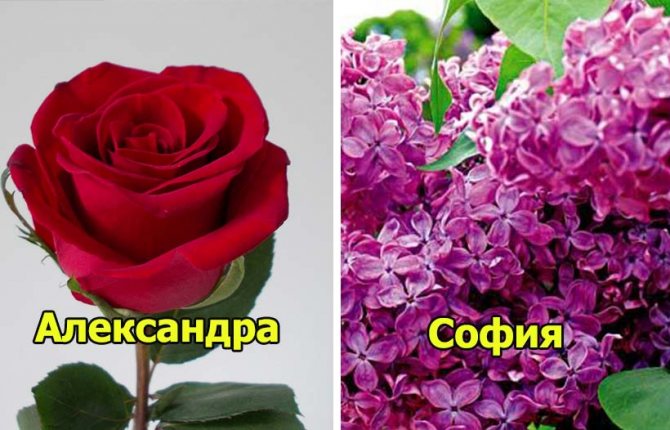

Often female names are consonant with colors - Rose, Lily, Veronica, Margarita, Hydrangea, Anyuta (pansies), etc. Among the female names there are those that are given in honor of rather rare genera of flowers: Constance, Wanda, Ada... All of them are from the orchid family, the genus Constance belongs to the tropical and subtropical orchids common in Brazil. In the subtropical regions of China and Southeast Asia, there are 60 species of the genus Wanda, in Colombia there are 8 species of the genus Ada.
In the myrtle family, the genus Evgeniya is considered the most numerous, about 1000 species, distributed in the subtropical and tropical regions of America, Australia and South Asia. Among them are economically valuable: the fruits of eugenia Sella, which have a pineapple smell and a wine taste, are used for food; leaves e. multi-flowered are used as a spice; in the cortex of e. Pitange contains the valuable substance citronelal, and its fruits are used to make jams and compotes.
Amateur flower growers are familiar with annuals from the Aster family. Some genus names sound in female names: Emilia (30 species grow in the tropics of America); Elvira (4 types of it are common in Mexico); Suzanne (3 species are found in Africa).
The legume family contains the genus Marina, which is represented by one species native to the mountains of Mexico, and the genus Elizabeth, including 10 species from tropical America. In addition, there are 200 known species of tropical plants found in America and belonging to the genus Inga... In the banana family, 2 genera are known, called Muse and Eizeta (banana). The name Muse, according to ancient Greek mythology, belonged to one of the 9 goddesses - the patroness of art and science - and symbolized creativity and inspiration.
In the flora of Central Asia and the Caucasus, there are plants of the genus Alexandra and Antonina from the labiate family. Plants of the genus are known in the tropics of Brazil Valeria from the family norichnikovye, in addition, there is a genus August (madder family), genus Clara (liliaceae family). There is a genus in the borage family Valentine, growing in distant Patagonia, and among the Hesierians - the clan Anna - in Indonesia.
The genus belongs to water lilies Victoria, whose plants live in the waters of the Amazon, they got their name in honor of the English Queen Victoria.
Synonymous names. Currently, in the botanical literature, some of the generic names of plants have passed into synonyms. For example, the genus Margarita became synonymous with the more famous genus Astra, Albina - Alpinia (ginger family), Tamara - Lotus (lotus family), Elena - Narcissus (amaryllidaceae family).
Psychology of color and human character: relationships


Each person prefers one color, at least no more than two or three (depending on where these colors are used - in clothes, furnishings, the color of the car, etc.). The pleasant or unpleasant feeling that a particular color evokes can change over time. But in any case, the color you prefer can tell a lot about your character and emotional makeup. Psychologists in such cases use a color test developed by Swiss psychologist Max Luscher in the late 1940s. The Luscher test, used by professional psychologists, requires special training for its application. The "lightweight" version of the Lyusherov test can be easily tested by anyone, using the usual setting of a modern color TV.
Psychologists say: if the red color predominates, then the owner of the TV is gullible, but overly emotional and aggressive. If yellow clearly stands out, then such a person inspires confidence in others, is an optimist and expresses friendliness. But the constant smile on his face is most often a mask behind which a strong internal tension is hidden. The predominant blue-green color indicates that a person is timid and weak, but dangerous if someone gets in his way. And, finally, those who prefer light blue are accommodating, lazy and do not know the measure in food and drink.
An experienced observer can also provide additional information about a person by their preferred color of the car. This can be proved by the data of the American psychologist Berthold Schwartz, who claims that the color of the car can be used to judge some of the psychological characteristics of its owner. So, the owners of red and yellow cars are optimists, lovers of life and consider themselves happy. Nature lovers and realists ride in greens. Blue is chosen by people with a balanced character. Owners of white cars are conservative, while black ones are used by business people. Gray and silver are for the taste of proud people, and brown ones are preferred by respectable spouses and fathers of large families.
What do flowers symbolize or what kind of flowers to give to a woman?
One of the common worries-headaches for men is the question of what to give to a beloved woman. We will also tell you about the main original gifts for women on our website, but how to choose an accompanying gift, that is, flowers for a woman, this is what this article is about. After all, each flower has its own meaning and symbolizes something, and if you have not yet had time to find out what kind of flowers your chosen one loves or decided to surprise not only with the choice of flowers, but also with the knowledge of what exactly your gift symbolizes, then this article is very will do. After all, knowing the nature of your beloved, you can choose the right flowers for him. And by presenting a bouquet of flowers, you express your special feelings for a person, you tell him something intimate.
The language of flowers is an ancient knowledge that was not just invented, this language is the result of centuries of observation that the sages of the east were engaged in. And this language is known as Selam. In addition to the relationship between a man and a woman, knowledge of the language of flowers will be useful to you in other areas of life, you will understand this when you read what exactly each of the flowers symbolizes.
White lilies - it is purity and not depravity.
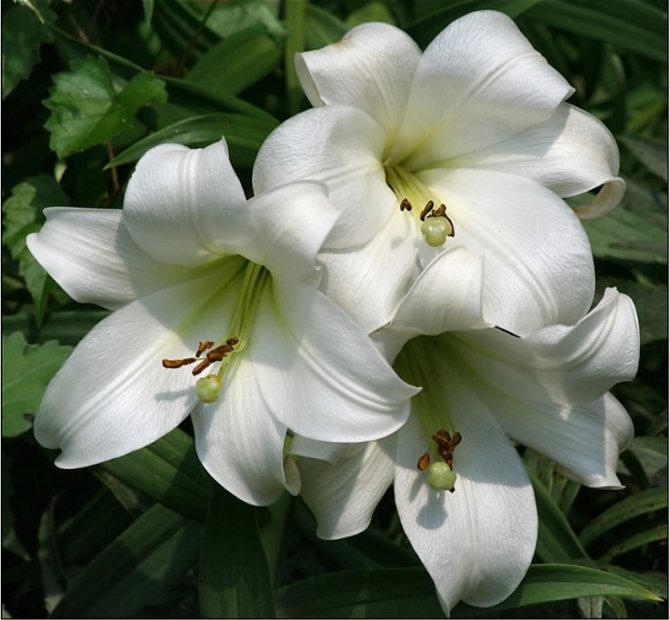

Chamomile - innocence, patience, beauty (especially in love)
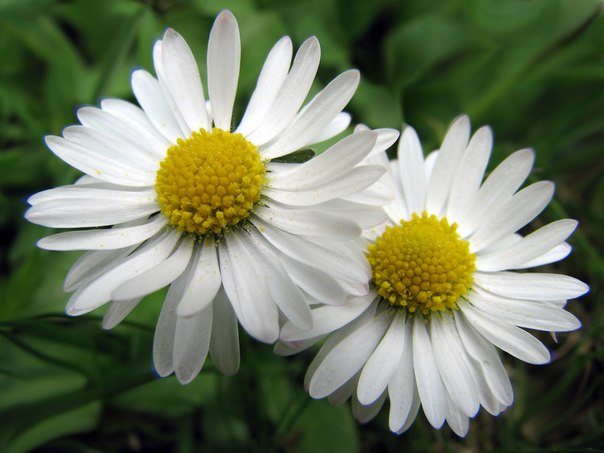

Red roses - longing desire, hot feelings.
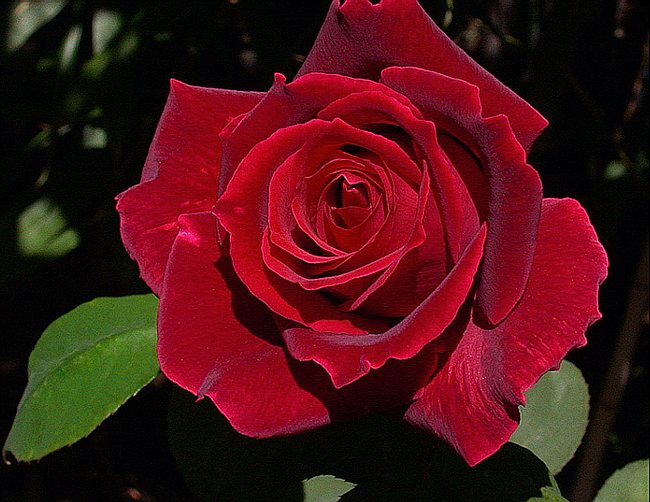

White roses - a symbol of harmony, purity, innocence, loyalty, pure love.
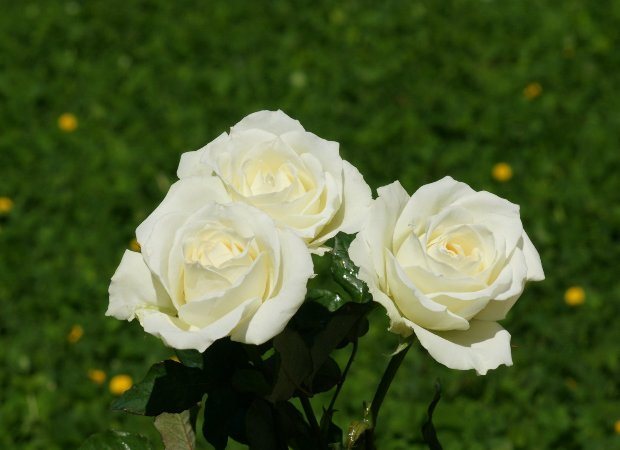

Pink roses - a symbol of romance, tenderness.
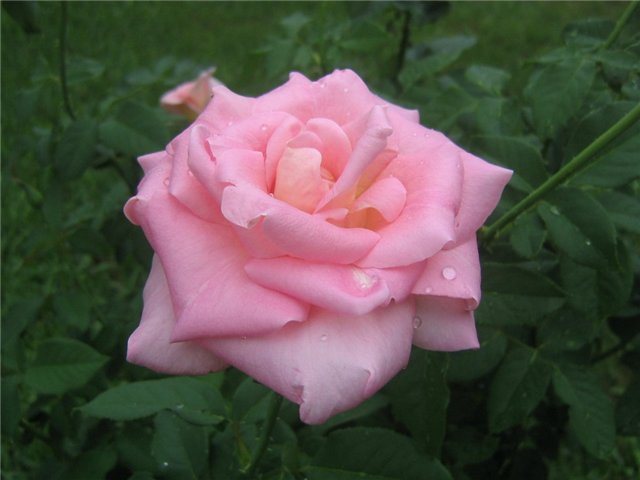

Yellow roses - a symbol of positive, friendship, joyful and happy emotions.
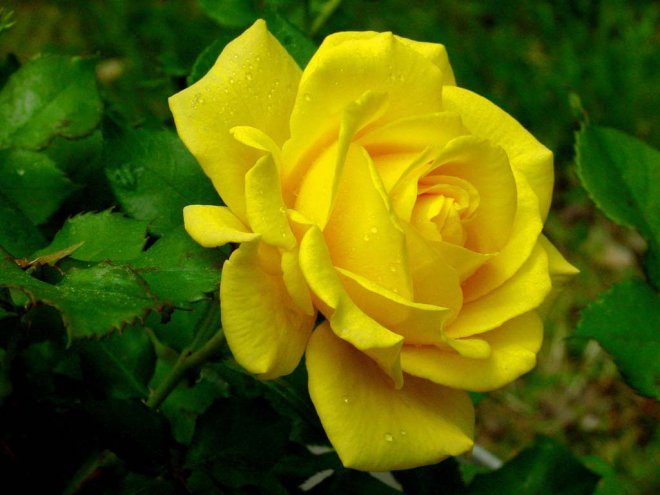

Burgundy roses - a symbol of love and admiration.
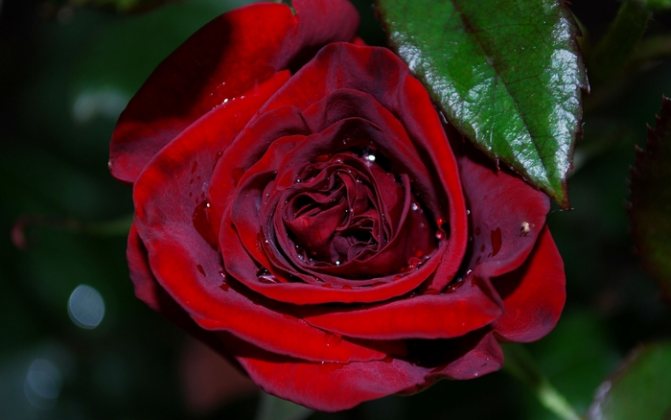

Coral roses - a symbol of passion and burning desire.
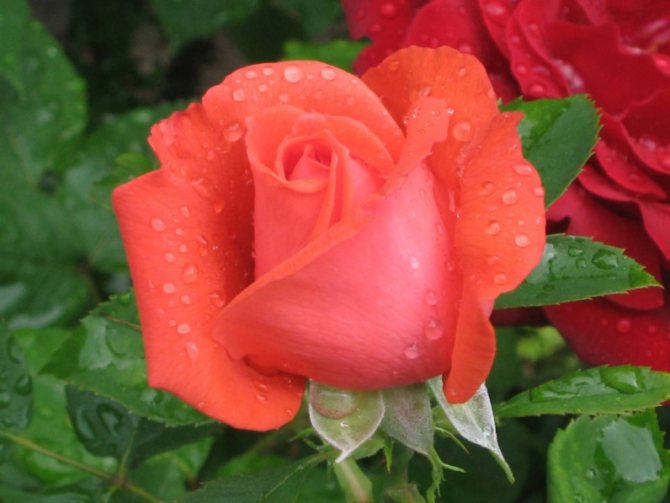

Blue roses - a symbol of the sacrament, the achievement of the impossible.
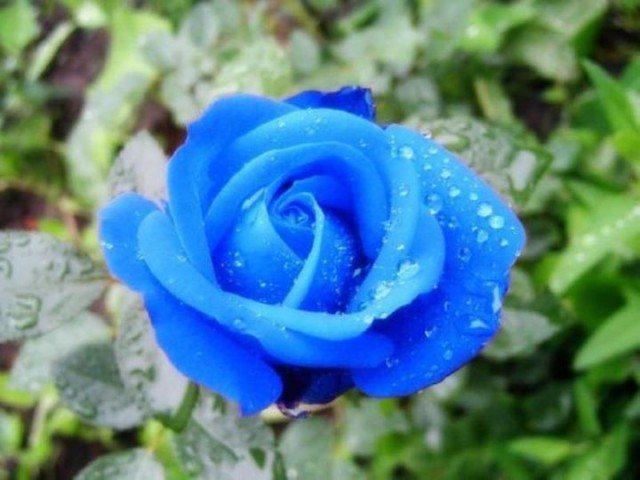

Orange roses - a symbol of abundance and wealth.
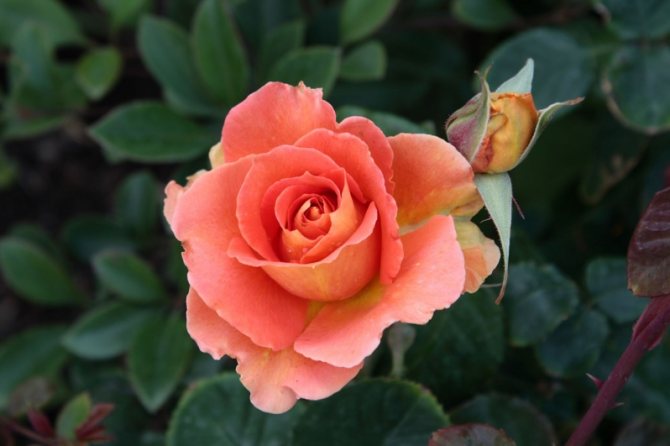

Mallow - symbolizes love for their people and land. A good gift for parents. A symbol of spiritual roots and ancestral heritage.
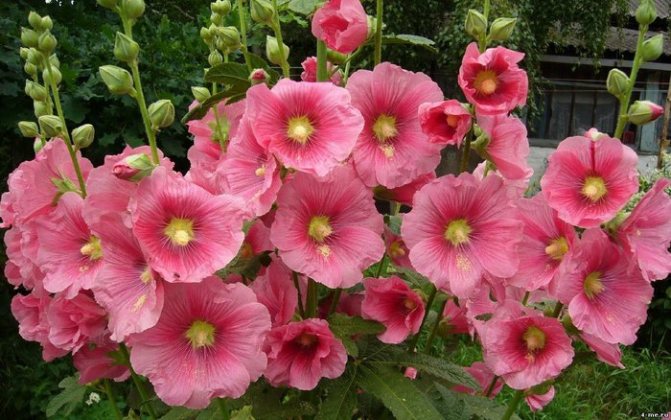

Periwinkle - for the strong in spirit and character, for strong-willed people. The name originates from the Greek word for winner.
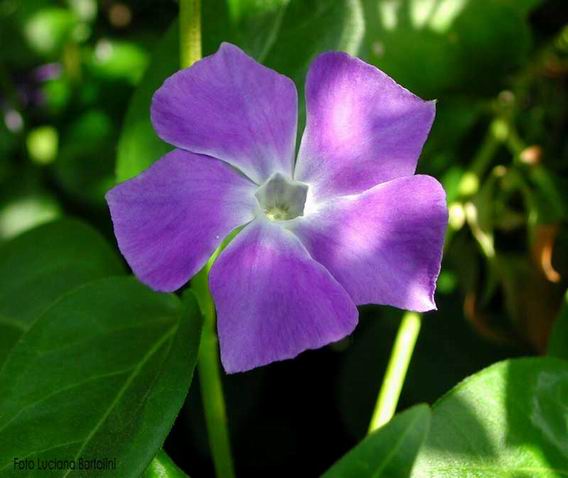

Gladiolus Is a gladiatorial flower whose leaves resemble swords. Symbolizes memory, sincerity, friendship, devotion and loyalty.
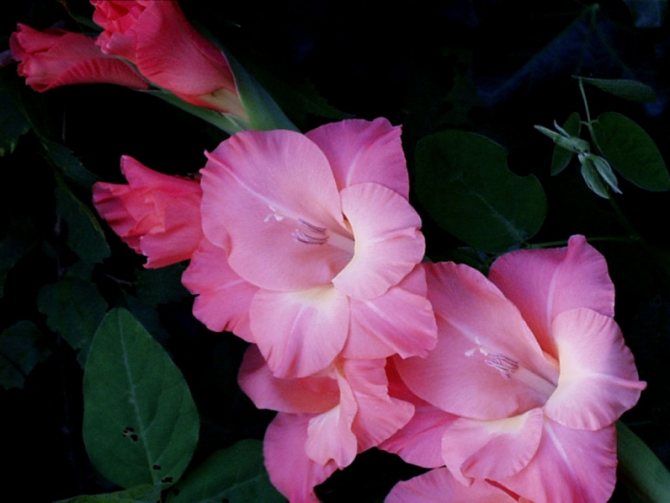

Tulip - a symbol of eternal joyful, ideal love.
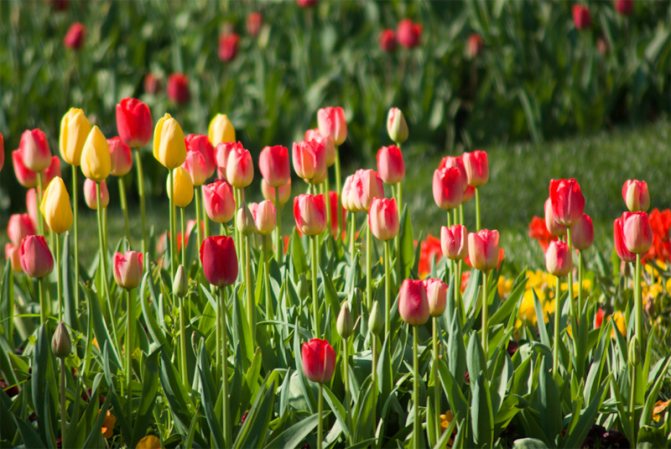

Orchid - this is a flower for lovers, symbolizes perfection, grace, tender love, intimacy, fertility, harmony. Orchid means beauty, perfection, grace, love, tenderness, intimacy.
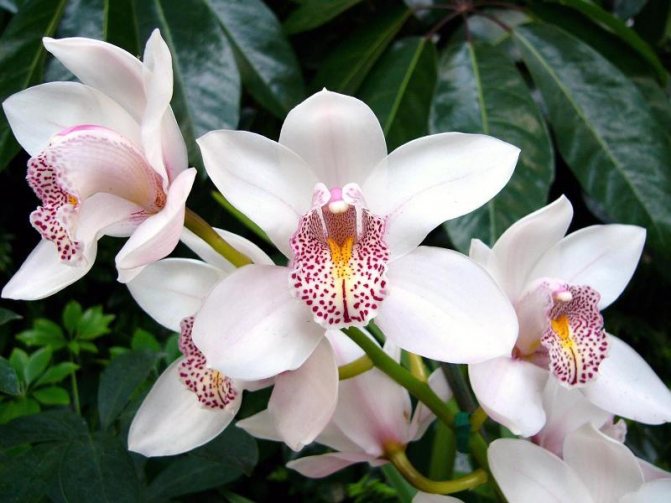

Kala - a symbol of beauty, poise, respect, worship, admiration.
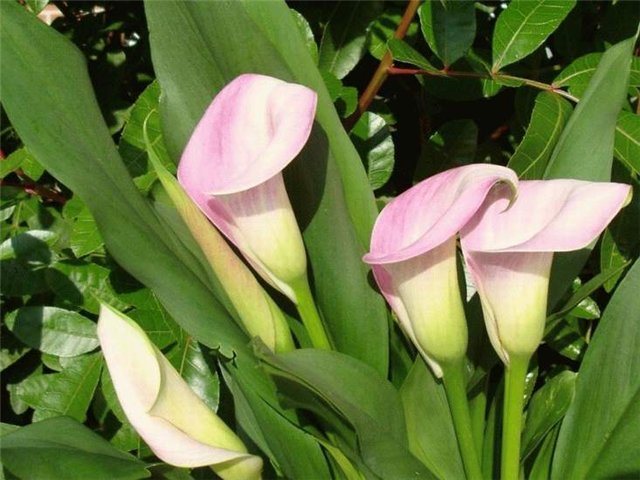

Carnation - an ambiguous flower, it is often used by diplomats for formal communication, on the one hand, a symbol of secrecy, on the other hand, it symbolizes maternal love and loyalty.
Purple carnation - a symbol of capriciousness, unpredictability.
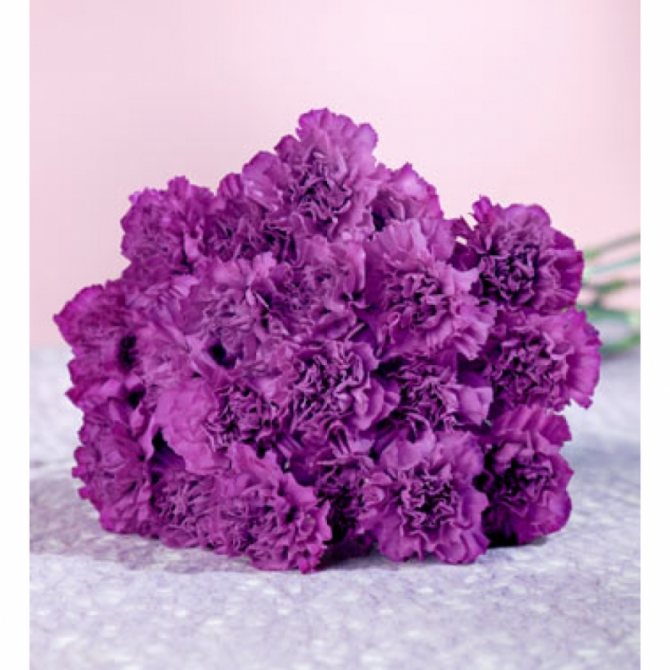

Red carnation - a symbol of admiration, pride, charm.
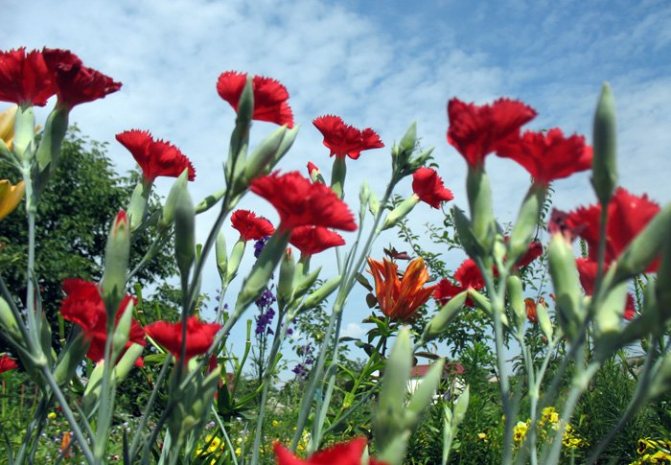

Carnation striped - a symbol of refusal, but with regret ...
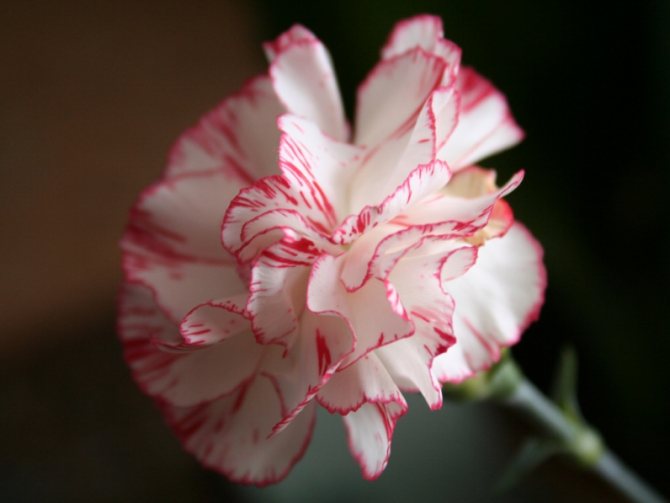

NarcissusSpring flowers and daffodil are not inseparable concepts - it contains several symbols at once: new beginnings, this is one of the meanings, and daffodils also talk about deceptive hopes and desires. However, the yellow daffodil is respect and irresistibility ...
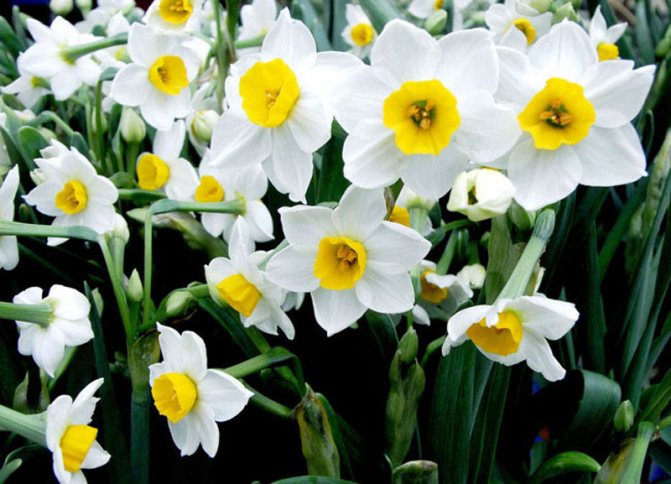

The daffodil is the most beloved flower among the British, English breeders have bred many varieties of this romantically delicate flower.
In Prussia, the daffodil is a symbol of love, happiness in family and marriage for many years. They also remember the custom of the old days: when a girl who was getting married dug a daffodil bulb in her parents' garden and took it to her new home. At home, she planted and took careful care of him, believing that the daffodil kept her family happiness. The Swiss tradition is a holiday of daffodils, lasting 2 days. On this holiday, cities were drowned in the flowers of daffodils: houses were decorated with them, they served as decoration for shop windows, windows and doors, daffodils served as women's decorations in the form of wreaths, men attached a flower to their collars, a fresh scent smelled over them. The celebration was accompanied by festivities and street theater performances.
Europeans believed that the flower has erotic power: flower bulbs served as talismans of love, were part of the rites of love and magic, elixirs from narcissus bulbs were given to men to strengthen masculine strength, and to women to enhance charm.
The meaning of colors in psychology - table
Below is a brief description and meaning of primary colors in personality psychology. Based on the preference for one color or another, everyone will independently be able to draw a conclusion about their psychological characteristics. Table 1 - The meaning of colors in psychology (briefly)
| Color | Color value |
| Red | The color of passions. If this is a favorite color, then such a person is bold, this is a strong-willed, domineering type, quick-tempered and sociable. Moreover, he is an altruist. People who are irritated by this color have an inferiority complex, fear of quarrels, a tendency to privacy, stability in relationships. The red color symbolizes excitement, energetism. This color is also a symbol of eroticism. Disgust, ignorance of red reflects organic weakness, physical or mental exhaustion. Prisoners of war, forced to live in life-threatening conditions for years, especially often rejected him. Red is the color most preferred by teenagers. |
| Yellow | It symbolizes calmness, ease in relations with people, intelligence. When he is loved, it means sociability, curiosity, courage, easy adaptability and taking pleasure in the opportunity to please and attract people. When he is unpleasant, then we are talking about a focused, pessimistic person, with whom it is difficult to establish an acquaintance. Yellow comes from mixing green and red and is the color of energy. The greatest preference for yellow is given to pregnant women who expect a successful outcome of childbirth, as well as people who are prone to changing places. Yellow is also interpreted as the color of illumination (halo / aura of Christ or Buddha). |
| Green | The color of nature, nature, life itself, spring. Anyone who prefers him is afraid of other people's influence, looking for a way to assert himself, since this is vitally important for him. Anyone who does not love him is afraid of everyday problems, the vicissitudes of fate, in general, all difficulties. Green color contains hidden potential energy, reflects the degree of volitional tension, so people who prefer green tend to self-confidence and confidence in general. Eccentric people, who achieve the assigned tasks not by purposeful volitional activity, but through emotions, reject the green color as unsympathetic. Along with them, green is rejected by people who are on the verge of mental and physical exhaustion. |
| Blue | The color of the sky, peace, relaxation. If you like him, it speaks of modesty and melancholy; such a person often needs to rest, he quickly gets tired, the feeling of confidence, the benevolence of others is extremely important for him. In rejection of this color, a person is revealed who wants to give the impression that he can do everything in the world. But, in essence, he is a model of insecurity and isolation. Indifference to this color speaks of a well-known frivolity in the field of feelings, although hidden under the guise of courtesy. In short, choosing blue as the preferred color reflects a person's physiological and psychological need for peace, and denying it means that the person avoids relaxation. With illness or overwork, the need for blue increases. |
| Brown | The color of individuals who are firmly and confidently on their feet. People who have a weakness for him value traditions, family. The preference for brown reflects, first of all, the desire for simple instinctive experiences, primitive sensual pleasures. However, the choice of this color as the most preferred color also indicates a certain physical exhaustion. Normally, along with black, brown is the color most often rejected by people. |
| The black | The color of uncertainty, symbolizing a gloomy perception of life. Anyone who prefers to dress in black often perceives life in dark colors, is insecure, unhappy, prone to depression, because he has no doubt that his ideals in life are unattainable. Frequent change of a black suit or dress for another, brighter, more catchy one, indicates that pessimistic moods are often dispelled. The constant choice of black indicates the presence of a certain crisis state and characterizes an aggressive rejection of the world or oneself (remember the black banners of the anarchists). Children who are acutely experiencing a lack of care and love often use black shading in their drawings. Normally, black is usually rejected. |
| Grey | Favorite color of judicious and distrustful natures who think for a long time before making any decision. It is also a neutral color preferred by those who are afraid to announce themselves too loudly. If you don't like this color, then this is an indicator of an impulsive, frivolous character. Often, the gray color is also preferable in severe overwork as a barrier that fencing off the stimuli of the outside world.In situations of psychological testing, this color is used as a means of protection against the penetration of another into the inner world of the subject. A study of about two thousand young men in a situation of competitive exams for filling vacancies showed that 27% of the respondents gave the first place to gray instead of the usual 5% in a normal situation. |
| White | A synthesis of all colors, so it is the “perfect” color. It has a significant meaning, since it simultaneously conveys both the brilliance of light and the coldness of ice. A person with any character can give preference to this color, he does not repulse anyone. |
Plant species
Of great importance for the correct composition of a bouquet are not only its color shades, but also those types of plants from which the composition is created.
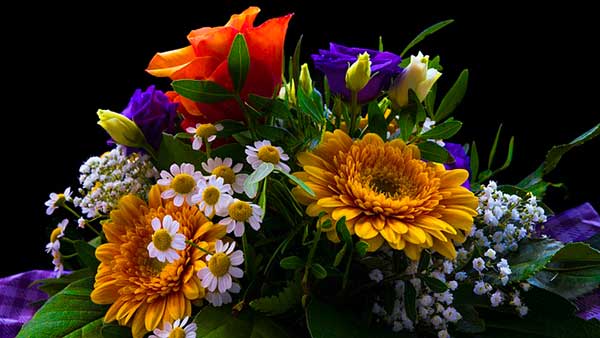

- Azalea. A symbol of femininity, meekness and fragility. And at the same time - passions and sorrows. Such a flower is given when there is a long separation. But at the same time, there is hope that everything will be fine with the second half - they will definitely wait for you. A sign of loyalty and unity.
- Asters. They carry love, sophistication and memories. There is a legend according to which asters were created from cosmic dust: the Virgo looked at the earth from the sky and cried. In nature, there are more than 600 species of asters. The most popular of them are Monte Casino. A bouquet made from only asters is sad.
- Cornflower . It contains grace, simplicity, delicacy and beauty. Cornflowers are often given to young girls as a sign of sympathy or friendship. Also presented when you have not seen a dear person for a long time, for example, your own grandmother. The donor of cornflowers should not be suspected of immodest desires.
- Carnations. The meaning of carnations in a flower language can be very different - it all depends on their color. But in any case, the donated carnation speaks of charm, female love, and at the same time honor and freedom. That is why carnation bouquets are often presented to people in uniform.
- Gerberas. Most often given to young girls when they want to talk about their feelings. Or used as a sign of attention. Feel free to choose these flowers if you want to share your great mood with someone or make a compliment.
- Gladioli. If you decide to give gladioli, a strong person lives inside you who does not accept compromises. A bouquet of gladioli will say for you: "I am really sincere." And he can also say: "Do not be afraid of anything, only go forward." The second interpretation makes it an excellent "load" for a first grader.
- Iris. It is the emblem of France. Embodies trust, wisdom, hope and fearlessness. Give such flowers if you want to say: "I value you very much," "I will always accept you as you are."
- Calendula. Despite the outward simplicity, the plant is considered a symbol of anxiety and fear. Calendula asks its owner: "Why are you behaving this way?", "I am waiting for an explanation." In bouquets on the occasion of the holiday, this flower can only be used as one of the ingredients.
- Crocuses. The symbol of spring and rebirth. It is believed that these flowers are able to refresh old feelings. With this gift one can say: “You gave me unforgettable moments”, “You will never, and no one can replace”. Can be used as a sign of reconciliation after a quarrel.
- Lavender. The embodiment of humility, humility and constancy. In the language of flowers, she says that the giver will always be there, just do not unnecessarily torment him with your whims. The flower is practical - it will delight the owner for a long time. The lavender bouquet will appeal to those who do not care about external tinsel and brightness, those who value inner peace and confidence in a partner.
- Lilies. They are considered a versatile flower. They are perfect for a bouquet not only for a woman, but also for a man. White - presented to young girls as a symbol of purity and purity. Other shades suit everyone. Especially in complex compositions.
- Daisies. Such flowers are bought when they want to say: "I am happy when you are happy." The person who presents the daisies deserves your reciprocity. A symbol of purity and innocence. No superficial gloss.
- Mimosas. It is traditionally given on March 8th. And also when they are embarrassed to confess their feelings. Sensuality and timidity matter. The flower is able to relieve stress and relieve fatigue, because it resembles a thousand little suns. Mimosa is the only yellow flower that can be given without complementing other shades and without hinting at separation.
- Forget-me-nots. Flowers can be put on a par with words such as memories, true love, loyalty, sincerity. There is a myth: the goddess of flowers Flora endowed all plants with names, but forgot about the little forget-me-not. This is how the name of the flower appeared.
- Peonies. These flowers embody the complete satisfaction of life - "I have nothing more to dream about." A bouquet of peonies of various shades can be a gift at a noisy and cheerful holiday celebration.
- Roses. Universal flowers for different occasions and different people, which speak first of all about the feelings of the giver. You should be careful with the red ones. For they are presented only to those to whom they have vivid feelings. Pink is a more neutral color that doesn't carry any additional hints. They want to say with tea roses: "I will never forget about you." There are also interpretations that consider the rose a symbol of silence or the embodiment of something infinite.
- Chamomile. The personification of youth, innocence, distrust and romance. The flower contains harmony, purity of feelings and trust. And from the middle a little sun bursts out: the energy of heat and light. An ideal gift in case of necessary reconciliation with your beloved. At the same time, it can be given to both children and the elderly.
- Tulips. Flowers of joy and happiness, suitable for almost any person and for any occasion. In our country, this is a traditional attribute of the spring women's holiday on March 8. The meaning of the color shade of a tulip usually fades into the background. But it is important to remember that these flowers cannot be given one at a time.
- Chrysanthemums. They are given when they want to express gratitude and sympathy. Red - express love, and white carry with them the purity of thoughts. Yellow ones are a symbol of tenderness. Buy chrysanthemums when you want to tell someone they are a great friend. And it's better to have different shades at once.
Poisonous
Adenium
It is also called Fat Adenium, Fat Adenium or Desert Rose, and all because of the stem, which is shaped like a bottle. It blooms very profusely, with bright beautiful flowers. However, its juice, getting on the skin and mucous membranes of a person, enters the bloodstream, causing poisoning.
In the homeland of Adenium, in Africa, the tribes of the aborigines to this day use the toxic sap of the plant to hunt for large animals, lubricating arrows with them.
Azalea
Azalea (Rhododendron) is a very beautiful plant. Its flowers are lily-like and when properly cared for, it blooms very profusely. But the juice and nectar of Azalea are poisonous. If you accidentally swallow a piece of a leaf or nectar, profuse salivation will begin, vomiting, lacrimation is possible. Rhododendron flowers have a strong odor that can cause allergies. This is manifested by skin rashes and headaches.
Dieffenbachia
Although Dieffenbachia cleans well and even humidifies the air, however, this plant is not suitable for living quarters, as it has a very poisonous milky juice. On contact with exposed skin, it causes ulcers and severe irritation. It is more dangerous if the juice gets into the eyes or into the mouth. In the first case, blindness threatens, in the second - severe swelling of the throat and tongue, and the person may simply suffocate.
For pets, Dieffenbachia's poison is deadly.
Croton
The plant belongs to the family of small peas, therefore, it also has a poisonous sap that can cause burns on the skin.And if it gets into the bloodstream with a cut or inside the body, it is fraught with resuscitation or death.
Spurge
So this plant is called because of its milky sap. You need to know that milkweed juice is poisonous, so keeping it in the house is dangerous. On the skin, it causes redness, burning, blisters. Milkweed juice is especially dangerous for the eyes, it can cause inflammation, temporary blindness and conjunctivitis. Do not taste it - it will cause poisoning, abdominal pain, vomiting, diarrhea, convulsions and poor circulation.
Mimosa bashful
Mimosa was dubbed bashful because of its ability to fold its leaves when touched. The pollen of this plant causes severe allergies. This plant can be poisoned quite badly only if it is eaten. Basically, the poison accumulates in the root system in special nodules.
Monstera
This exotic plant is famous for its wide leaves with unusual cuts. It is in the juice of these leaves that the poison is contained. If, through carelessness, the juice gets on the skin, it can cause burns, blisters, redness. If the juice gets into your eyes, you can temporarily go blind, get conjunctivitis and burns.
Monstera is one of those flowers that, according to signs, cannot be kept at home by single women.
Oleander
Despite its beauty and love of flower growers, this flower is very poisonous. Even the scent of this plant makes you dizzy. If Oleander juice gets on the skin, burns appear, and if it gets inside the body, it causes serious poisoning. It can cause blindness if it gets in the eyes.
Nightshade
It is a beautiful evergreen, abundantly strewn with bright orange berries. All parts of the nightshade are poisonous, but it is the attractive berries that are especially dangerous. It is strongly not recommended to grow it in an apartment if small children live there. The child will definitely try the bright berry, and it can cause a strong digestive upset.
Ivy evergreen
A very common houseplant that pleases the eye with its glossy leaves. The poison is found both in the leaves and in ivy berries. If poisoned, it can cause delirium and cardiac arrest.
Primrose
Indoor primrose with a rosette of leaves and a variety of colors of flowers is not so harmless. The venom from this plant causes skin rashes, itching, irritation and even eczema.
Trichocereus
Trichocereus is a cactus with long spines. It blooms with white inflorescences with a strong odor. This plant is poisonous as it contains alkaloids and hallucinogens that paralyze the nervous system.
Ficus
Ficuses are very common indoor plants. Their stems and leaves are poisonous. The sap of the plant, when it gets on the skin, causes redness, irritation and blisters. Also Ficus can cause severe allergies.
Philodendron
Wonderful greens are very much appreciated in this plant. Some Philodendrons are vines, others are bushes. All species are poisonous. The poison contains plant juice, it is very dangerous for the eyes and skin. An intact plant is absolutely safe.
Cyclamen
Cyclamen's poison is similar in composition and action to curare poison. The tubers are the most poisonous in this plant. Tuber juice is used in folk medicine, but it must be treated very carefully.
Black - sophistication, officialdom, luxury and sorrow
Values. Black symbolizes the classics and, despite its involvement in death and all the mystery, when used correctly, can make your brand the most recognizable. In branding, black is associated with exclusivity and luxury.
Helpful advice. Black goes well with gold and white colors. Texture plays an important role: depending on whether it is matte or glossy, the message of the design idea may change.


Design Film Festival symbols
Combining different textures and black and white colors, the logo design is classic, yet incredibly sophisticated and extravagant.
Brown - organic, decency, honesty and simplicity
Value.Brown symbolizes naturalness and looks organic when it comes to food, beauty and body care products. In other company logos, it can be associated with honesty and reliability.
Helpful advice. Be careful with brown as it sometimes looks like dirt. On the other hand, if your activity is related to soil or some kind of dirty production, brown will be very useful.


Museum of Ceramic Arts and Crafts Brochure
Brown is the color of clay, and this is what dictated the choice of designers.


Branded products of XXY store
Shades of wood symbolize simplicity and consistency in the corporate design of the XXY fashion brand.
White - purity, simplicity, innocence and minimalism
Value. White is transparency, simplicity and perfection. Apple is a good example of the use of this color in branding - white embodies the simplicity, functionality and modern design of their devices.
Helpful advice.Choosing white as your logo color will take every effort to highlight your own personality. Even a simple object should have a twist.


Logo by designer Thomas Wightman
The logo symbolizes the style of the designer himself, emphasizing his laconicism and minimalism.


Signature logo of the studio of design furniture Håndvaerk
The highlight of the Håndvaerk brand is sophisticated simplicity, clean lines and discreet luxury. All these qualities are combined in their corporate logo.
How does the meaning of peonies change or supplement depending on their color
The wide range of colors of peonies allows you to achieve results by combining different shades in one bouquet or in a limited space.
The aggressiveness of the red color can be suppressed by the presence of white peonies. This combination is popular when forming bouquets of roses. Red peonies combined with light-colored roses have a very strong effect.
A similar effect is achieved by combining red with yellow or cream.
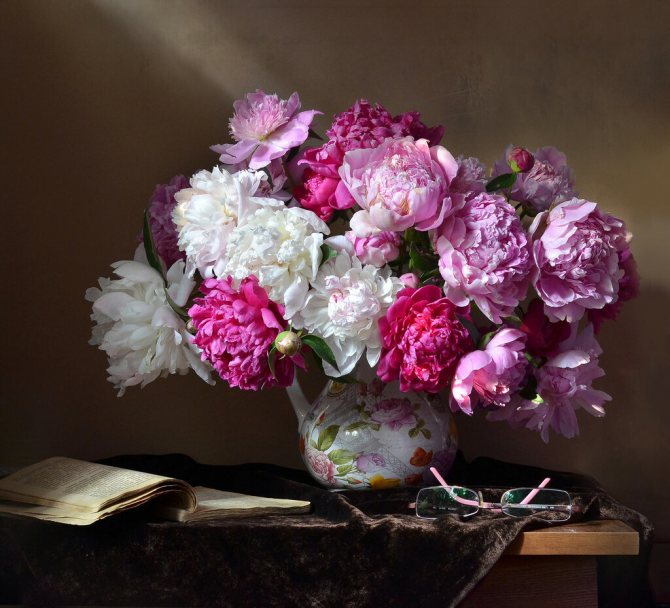

Bloom
The plant does not like when it is rearranged from place to place, therefore it is better not to move or twist the pot with it once again. For an abundant flowering of azaleas, you need to regularly prune and pinch the shoots. The last time they do this is in May, because the laying of flower buds begins in June. A very lush bush will not bloom well. 4-5 leaves are left on the stem, young shoots near flower buds are also pinched. What does indoor azalea look like: photo Dried and faded buds must be removed. After pinching, the flower is treated with a weak solution of potassium permanganate. The plant needs a cool content for vigorous flowering. With careful care, azalea flowers grow in size and quantity every time. The flowering period depends on the variety.
The meaning of colors in Feng Shui
Indoor plants are able to have a beneficial effect on the health of residents - they can improve mood, relieve headaches, fatigue. The best feng shui flowers for a home cleanse the energy of the home, protect it from negative influences. In order for the plant to have a beneficial effect on people and space, you need to choose the right green friend, determine his place for him and provide care.
Azalea flower - its meaning in Feng Shui
This plant is the best donor, it gives the energy of creativity and creation. With the syndrome of constant fatigue, you need to know which Feng Shui flowers in the house support the energy of vigor. Azalea will help restore strength, return inspiration to those who move like a sleep fly all day. She develops sensitivity to people, awakens the ability to love. The scent of azalea is moist and light, it contributes to the concentration of the mind and the purification of thoughts. At the physiological level, it regulates the work of the heart, chest organs and blood circulation. In order for the azalea to take root in the house, it needs to be taken care of.
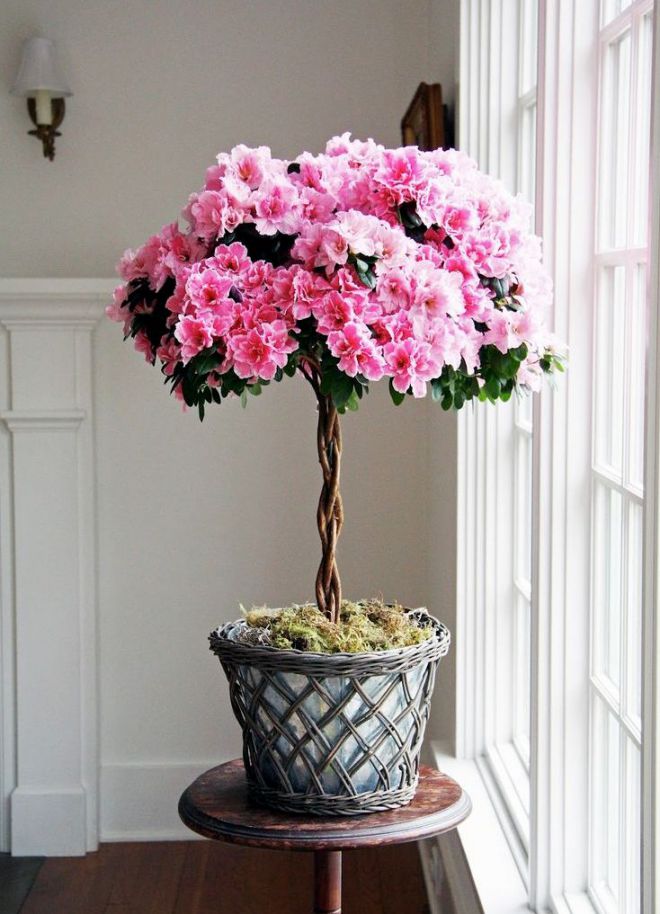

Guzmania - the meaning of a flower in Feng Shui
It is a lush green plant with thin long leaves and a bright rosette. Guzmania helps to raise the mood of the owners, protects against depression, improves well-being. Such flowers in a Feng Shui apartment should be located in the southwest or east sector. They help to create a peaceful atmosphere in the family, normalize relations, shades of red will help maintain a feeling of love among the spouses. Yellow guzmania will attract good luck and
financial opportunities. By placing a diploma next to a green friend, you can receive recognition of your professional activity.
Calla lilies - the meaning of a flower in Feng Shui
Each plant, according to Chinese teaching, is a kind of talisman for the home and family members. To gain powerful protection from evil forces and diseases, women use white and yellow calla flowers, their Feng Shui meaning is a guardian of family happiness. They help to create a successful marriage, are a symbol of beauty and youth. Calla helps to resist depression and stress, to create and act, regardless of the circumstances. Not only the living flower itself has magical properties, but also its image. It is appropriate to use it in clothes, hang a picture at the entrance to the house.
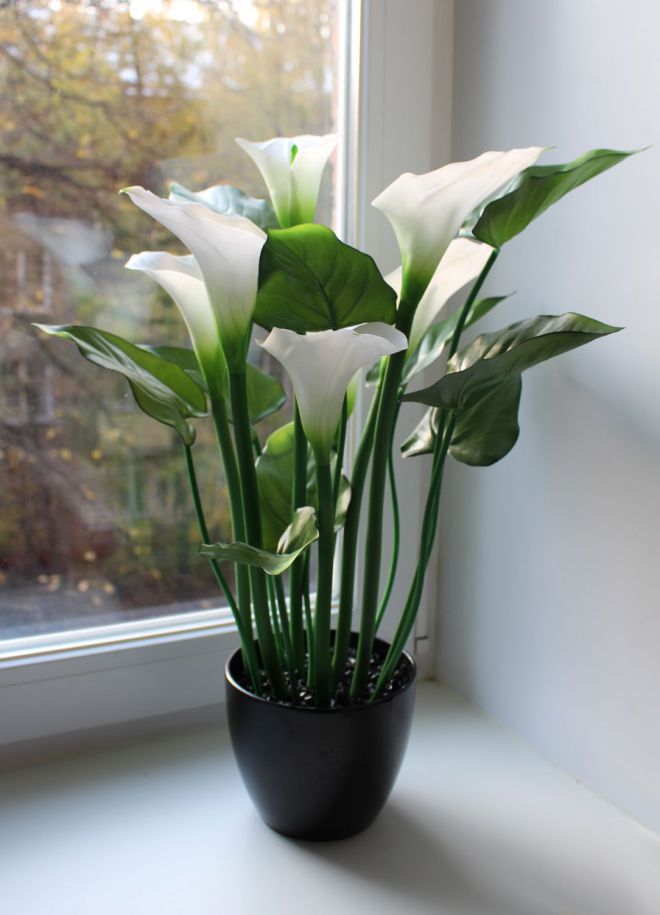

Indoor flower Crassula - Feng Shui meaning
The famous money tree is considered an energetically strong plant in Chinese teaching. improves the financial situation of home owners, brings them happiness and good luck. It is better to arrange such flowers on the windowsill, according to Feng Shui, the southeastern sector of the apartment is responsible for the increase in financial well-being. It is recommended to grow the tree from the cutting itself, so that it feels the care of the owner, absorbs the energy of the house. You can decorate it with coins, red ribbons, set the pot on a purple napkin with the hieroglyphs of wealth.
Feng Shui Plumeria Flower
This is an amazing paradise beauty tropical tree with a graceful scent. His fragrant flowers are white-yellow and crimson with petals of the correct oval shape. The plant is considered a tree of life and a symbol of immortality; in Hawaii and Thailand, it is often planted near temples, where it is more popular than lotus and orchids. It is better to place such feng shui home flowers in the southern corner of the apartment; you can use the bedroom window sill for this. In addition to heavenly beauty and a wonderful aroma, the tree has a strong energy, helps its owners to maintain health and gives longevity.
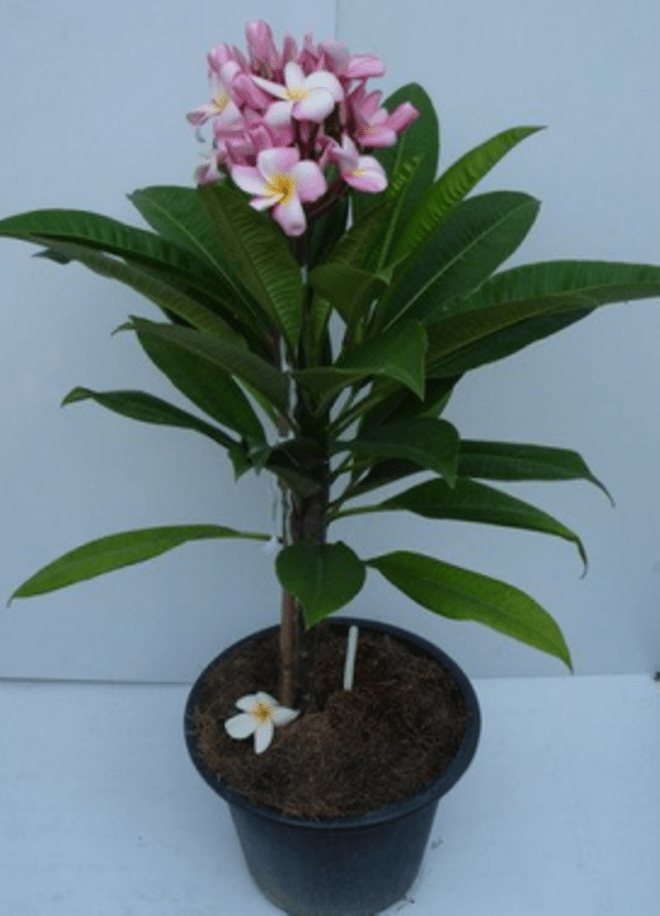

Feng Shui nematanthus flower
This is an unusual shrub from Brazil. In the axils of the nematanthus (hypocyrtes), in dense dark green leaves, original orange buds are formed, similar to a goldfish. Such flowers in a Feng Shui apartment are considered healers for other plants. Even sick relatives begin to recover near the nematanthus. The hypocyrt has the most beneficial effect on a person - it takes away negative emotions, and in return gives peace of mind, helps to achieve financial well-being. The main thing is to provide the plant with proper care so that it is in a healthy state.
To create a favorable atmosphere, fresh flowers are needed in the house; according to Feng Shui, any plant has its own energy. Knowledge of the impact of each variety on a person and the surrounding space, the ability to correctly draw up a phytodesign and arrange specimens in the right places will block the negative impact from some green representatives of the flora and saturate the home with positive, achieve spiritual harmony. In order for a flower to show all its strength, you need to install it in the right place, show care and love for it, say good words, and thank for your help.
In the cool mountain forests of the northern hemisphere, azaleas form thickets, at home, in India, they grow a meter and a half - a kind of shrub, even a miniature tree.In Japanese culture, azalea is often used to form bonsai, because the plant is plastic and resistant to the vagaries of nature and climate change.
Azalea is sometimes called majestically - the flower of sages, perhaps for large flowers that allow you to contemplate them for hours and gain wisdom from the perception of beauty. In our conditions, azaleas are afraid only of severe frosts, therefore, with the onset of stable frosts, the bushes must be covered with non-woven material, on top of which to throw snow.
You can buy her blooming
In flower shops, along with azalea seedlings, you can also find her younger sister - the potted azalea culture, whose place is on the windowsill. There is a strong opinion that it is impossible to buy flowering azalea plants: supposedly accustomed to one conditions, they will not withstand the transition to others, and as you know, the time of flowering is the most dangerous and very gentle period for culture. As for the azalea, truth is intertwined with fiction. Indeed, it is not worth buying a flowering plant, but only in winter, and only because of forced transportation. Five to ten minutes in the cold can kill any flowering plant. In the summer, the plants sold in pots, that is, with a closed root system, are quite suitable for buying and even transplanting to a new place during the flowering period. The main thing is not to destroy the earthen lump in any way.
When choosing a plant in a nursery or in a flower shop, carefully examine it. It should be a healthy flower with no leaf spots, no damaged or partially wilted shoots.
Demanding only on the acidity of the soil
Azaleas, which is quite unexpected with their beauty, are completely undemanding to care for. They can grow in any soil. The main thing is that the pH level is approximately equal to 4.2-5.9, and it is undesirable to change this threshold in either direction. It is simple and easy to grow azaleas as a pot culture, you can buy a special soil for heather and not worry about anything. But the garden soil will have to be studied, and then equalize the acid-base balance.
Azalea loves the sun ... with a light shade
It is better to choose a sunny place for an azalea - in the garden it is an open area, protected, however, by a shade from the scorching sun at midday hours. If there is no opportunity to cover it with a shadow, then the azalea will cope with the gusts of the "solar wind". Especially if you water it every night.
The flower pot of the house should be placed on the south side, on wide and light windowsills. Light window sills, like light pots, do not heat up from the sun, so they will not harm the plant. It is necessary to water the home azalea, as well as the street one, daily, little by little, and during the periods of bud formation, during the mass flowering and during the preparation for winter, it is also advisable to spray the home azalea with warm water. Any, even short-term, lack of moisture causes the azalea to shed flower stalks, the plant experiences prolonged stress, it can die.
How to feed the flower of wisdom
Accepted with gratitude azaleas and feeding. Doses for outdoor plants are much higher than for indoor plants. And is it worth feeding an azalea that grows in specially selected soil? The street one needs nourishment - it is peat, leaf humus. In combination with watering and mulching the soil, they will give an excellent result, which will affect primarily the foliage: the leaves will become brighter, there will be more of them on the flowers, and they will bloom longer.
Hydrangea benefits
By correctly choosing flowers, you can create a real work of floristic art. Hydrangeas, the bouquet of which is sure to be magnificent and delicate, will give the recipient a lot of positive emotions and unforgettable pleasant impressions.
The advantages of this flora for composing compositions are many:
- These plants go well with other types of flowers.In the composition, you can use both regal roses and delicate ranunculus or peonies; hydrangea will look equally great both in those and in other versions.
- You can give hydrangeas for absolutely any occasion. It can be either an unexpected gift for your beloved woman or a gorgeous composition for a wedding or anniversary.
- In terms of economy, a hydrangea bouquet is just the perfect solution. These flowers, for all their grace, are inexpensive. Therefore, for the donor, this option will not be an invoice for the wallet.
- Delightful and delicate flowers keep their freshness for a long time. It is enough to change the water in a vase with flowers once a day, and the bouquet will delight you for up to 2 weeks.
Diseases and pests
Like all indoor plants, red gerbera can get sick (read about the most common gerbera diseases and how to deal with them in this material). The reason for this may be the wrong content of the flower.
- Alternaria... The disease is fungal in nature. The leaves of the plant are covered with brown spots, which brighten over time. In some cases, the disease can only manifest itself as yellowing of the leaves. In conditions of constant excess of moisture, the spots are covered with a dark bloom.
Attention: The weaker the gerbera, the higher the likelihood of developing the disease. - Gerbera mosaic... Caused by the cucumber mosaic virus. The main symptom is the appearance on the leaves of yellow-green spots of various sizes and shapes. Infection occurs through insects such as aphids.
- Sclerotoniosis... Called by a fungus. It manifests itself in the form of depressed spots on the surface of the leaves, covered with a light bloom. The fungus can persist in the soil for a long time.
- Powdery mildew... Another type of fungal disease, which is most susceptible to young plants. A grayish bloom appears on the leaf petioles, develops and covers the entire plant. Without timely intervention, the gerbera inevitably dies.
- Late blight... It manifests itself in the form of gradual drying of leaves, first from the outside, and then from the inside. Root decay follows.
- Gray rot... Light bloom affects the inflorescences and leaves of the plant. The disease spreads through soil and water.
- Aphid... It sucks out plant juices, multiplies at high speed. Spider mite Forms a thin web, able to braid the whole flower.
- Whitefly larvae... They feed on plant sap throughout their development.
If your favorite flower does not bloom in any way or its leaves suddenly turn yellow, do not worry. The following publications will help to solve the problem:
- Why do the leaves of room gerbera turn yellow and how to cure it?
- Why don't gerberas bloom and how to fix it?
What symbols does the color palette indicate?
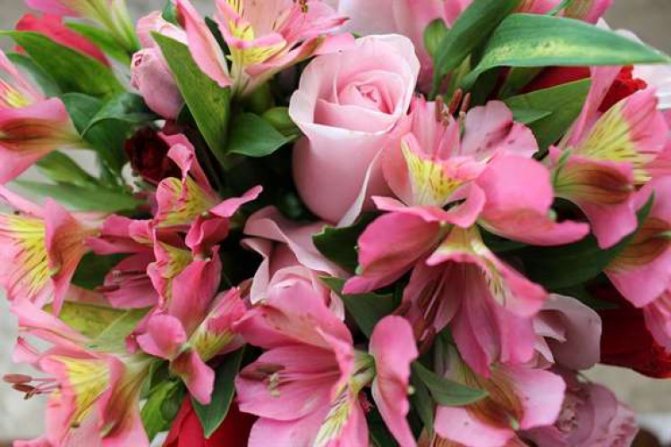

What do vegetal floral shades mean? It is also worth listening and looking closely, many definitions have been discovered by psychologists.
- The yellow ones, although they are already given with a calm soul and showing sincerity, but earlier to receive a yellow flower meant an early break.
- White is the base color for any bouquets, but it means the purest emotional urges and intentions.
- Pink is modesty.
- Red is passionate ardent love.
- Burgundy - means strong love.
- Unfortunately, black is a symbol of sadness and death.
- Blue - you are inaccessibility or difficult to guess.
- Lilac means majesty.
- Turquoise is a symbol of tranquility and peace of mind.
Where and how to plant?
Red gerbera can be planted both at home and in the garden. In garden conditions, gerbera planting begins towards the end of winter. Seeds for seedlings are sown in special containers with a mixture of sand and compost. The best time to do this is between January and March. Gerbera seeds have a low germination capacity, so they are sown in large quantities (we described in detail here how to properly grow gerberas from seeds). The first shoots appear in one and a half to two weeks.
Important: Do not plant seeds too deeply, this greatly reduces the percentage of germination.
After the appearance of several leaves, the seedlings can be transplanted into separate pots. Seedlings need regular watering... However, excess moisture cannot be allowed, as well as water ingress on the root outlet - the plant may begin to rot.
Lighting and location
Seedlings can be planted in open ground after they are no longer threatened by night frosts. It is best to find a sunny, but not too hot place to avoid scalding.
Window sills facing the east or west sides are suitable for indoor varieties of red gerbera... On the south side, the plant will have to be shaded at noon.
Soil requirements
The soil for planting a red gerbera should be light, well-drained and contain enough inorganic fertilizers. With an excess of organic matter, the peduncles will stretch strongly.
Orange - freshness, youth, creativity and adventure
Value. Orange combines the warmth of red with the optimism of yellow. Oranges and carrots are also orange, which makes this color a symbol of health, youth and vitality.
Helpful advice. Since orange is more associated with youth and novelty, it may not be suitable for luxury brands and companies doing serious business.


Feeding the Self Employee Business Cards
Feeding the Self helps South Africans build their own gardens and orchards. Their logo is a great reflection of their business.


Symbols of the creative agency Full Orange
Orange in the colors of the logo is a symbol of the company's creativity and energy.
Botanical description
Red gerbera is a perennial herb... Its leaves are large, tough, pointed at the ends.
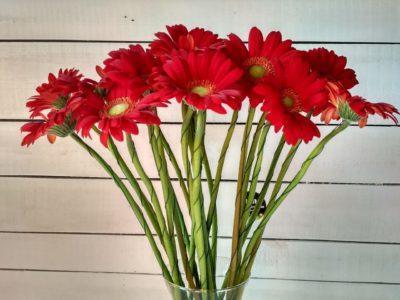

Collected in a root socket, in length, as a rule, does not exceed 30-35 centimeters. The edge of the sheet can be either solid or serrated. Petioles are long, sometimes pubescent.
Peduncles are tall, devoid of leaves, often pubescent. Flowers are collected in inflorescences-baskets of various sizes, outwardly, gerberas resemble chamomile flowers.
The marginal flowers are ligulate, they are larger and brighter. Median - tubular, smaller.
The fruit is achene. Gerbera seeds are viable on average for six months..
Flower | Hydrangea
)
Hydrangea (Hydrangea macrophylla) is a plant with many names and a complex fate. At the end of the 18th century, the French physician and naturalist Philibert Commerson brought from Japan a flower ("Japanese rose") now known as the large-leaved garden hydrangea. In Japan, she was called Ajisai.
.
* * *
A series of messages "Nature - the world around us":
Part 1 - National Geographic Part 2 - Nature is always perfect - Life under water. … Part 29 - The Art of Photography | MacroWorld Part 30 - Floral | Gladiolus Part 31 - Floral | Hydrangea Part 32 - Japanese Landscaping | Garden Part 33 - Sunday positive | In the world of love and friendship ... Part 45 - Now you can see the world with the "eyes" of drones Part 46 - And this is Georgia in winter ... Part 47 - My Toby | French Bulldog
What does hydrangea symbolize? What are the legends about hydrangea?
Natalia yu
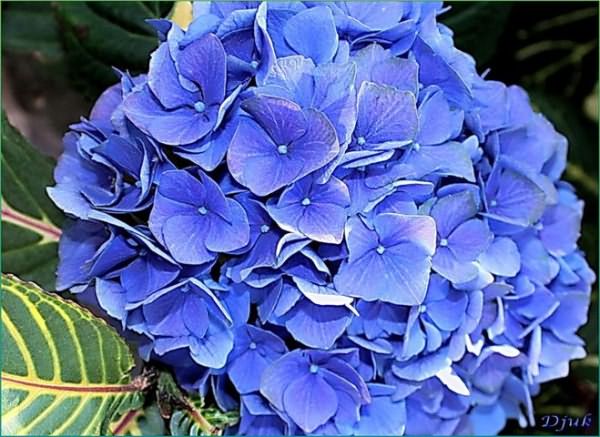

Hydrangea or Hydrangea macrophylla (Large-leaved hydrangea) means a vessel of water in Greek, which emphasizes its love for water, it grows in moist soils. At the end of the 18th century, it was brought from Japan, conventionally called the "Japanese rose"; in Japan itself, the hydrangea was called Ajisai.
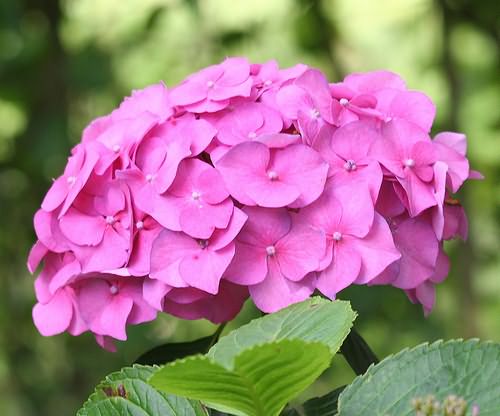

There are various legends associated with this beautiful plant. So in the Japanese legend it is said about the emperor, who sent a bouquet of hydrangeas to the parents of his beloved girl to apologize to them, so they began to associate hydrangea with cordiality and sincerity.
But in other countries, they believe that hydrangea is a symbol of indifference, coldness, vanity and even boasting. believe that hydrangea is a symbol of unrequited love.
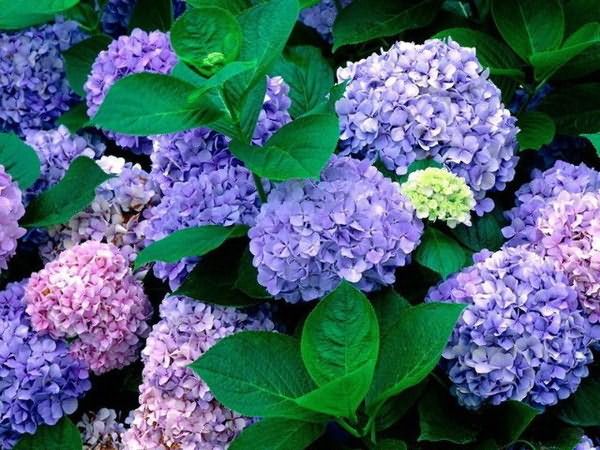

There is another legend that is associated with Nicole-Rein Etable de la Brière (married to Madame Lepot), who in her youth made a dangerous sea voyage as a girl, almost died, and then became a famous mathematician and astronomer. In honor of her merits, the hydrangea began to be called "Potia", later it was renamed into hydrangea and began to be called Hortense Lepot, then this confusion was removed, but still many people still call this plant the French hydrangea.
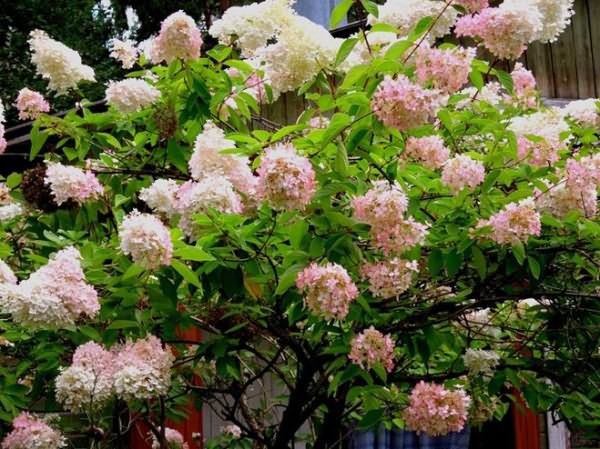

>
Breeding features
There are three main ways of reproduction of red gerbera: by seeds, cuttings or dividing the bush.


Seed propagation... This is the longest and most laborious method, so it is rarely used. The period from planting seeds to flowering takes 9-10 months.- By cuttings... In this case, a part of the gerbera stem with a leaf will be required, and a mother plant no older than three years is best suited. In moist, heated soil, young shoots will appear in a week.
- By dividing the bush... A neat, not too deep cut is made on the rhizome of a young gerbera. The place of the cut is sprinkled with crushed coal and dry soil. Gerbera should have new roots in a month. When this happens, the plant is split in two and planted in separate pots.
You can find out more about the ways in which gerberas can be propagated at home and about the necessary follow-up care in our article.
Thus, the red gerbera is perfect for both the gardener and the lover of indoor plants. Low requirements and availability make it almost ideal for breeding and cultivation.
If you find an error, please select a piece of text and press Ctrl + Enter.
Allergenic
Alocasia
This is a representative of the Aroid family. All plants in this group are toxic. Allergies are caused by juice, so they need to be transplanted with gloves to protect the skin, and a gauze bandage will also do the trick.
Geranium
Pelargonium (Geranium), the leaves of which contain a large amount of essential oil, can cause allergies by its smell. But this pungent scent is only released when the plant is touched.
Hydrangea
An allergen is the juice of this beautiful plant, which is present in the stems, leaves and flowers. On contact with it, rashes, itching, weakness, nausea may appear.
Lily
Beautiful flowers have a very strong odor, from which the head hurts and dizzy, allergies appear, and faints occur. Lily juice is very poisonous. It can be fatal if ingested. There is no antidote for this poison.
Orchid
Orchid causes allergies in people with weak immunity - breathing is difficult, a stuffy nose, mucous membranes can swell. For allergy sufferers, the scent of this flower is deadly due to swelling of the throat.
The strong smell of Tuberose causes allergies, suppresses the psyche, and causes headaches. In the dark, this plant absorbs oxygen and emits carbon dioxide.

